
Pope Paul VI rides into New York’s Yankee Stadium on his Popemobile in 1965.
- POPE FRANCIS IN THE U.S.

Three Popes Have Visited the United States—Here's What They Said
If previous papal visits are any indication, Pope Francis will arrive with a clear-cut mission.
Pope Francis is the 266th head of the Roman Catholic Church , but his visit to the United States next week makes him just the fourth pope to step foot on American soil.
The first three to make the trip were the last three long-serving popes—the list excludes John Paul I, who was pope for just over a month—a sign of how important U.S. visits have become for church leaders. “Popes come here not just to speak to the United States, but to speak to the world,” says Stephen Schneck, Director of the Institute for Policy Research & Catholic Studies at The Catholic University of America .
Here’s what happened when previous popes visited:
Pope Paul VI
The first pope to visit the United States, Pope Paul VI arrived on an ambitious mission in 1965. It was a time of mounting obstacles to world peace—the middle of the Vietnam War, Cold War tensions rising, and yet another vote set for the United Nations to include China as a member. Paul wanted to “invoke the consciousness of the world,” says Schneck.
( Take an amazing 360° tour of St. Peter’s in Vatican City from your chair .)
Paul addressed the United Nations at its New York City headquarters. “It is peace—peace—that has to guide the destiny of the nations of all mankind,” he said, urging member states to move toward disarmament. “A person cannot love with offensive weapons in his hands.”

President Jimmy Carter talks with Pope John Paul II at the White House in 1979.
Pope John Paul II
With five official visits to the United States and two stopovers in Alaska, John Paul II visited the country more than any other Holy Father. “He was very much a pope on a plane," says Schneck, making official visits in 1979, 1987, 1993, 1995, 1999 and visiting more cities than any other pope—from Miami to San Francisco, from San Antonio to Detroit.
John Paul wanted to visit followers where they lived, focusing on young people. He felt “the future of the church lay in cultivating a relationship between the church and the youth of the world,” says Schneck. In August 1993, John Paul brought World Youth Day, an evangelical event he had staged around the globe, to Denver, Colorado.
( Read 10 of Pope Francis’s most provocative quotes. )
During the festival he visited Mount Saint Vincent , a facility that cares for young people with special needs. “You are our love, you are our joy, you are our greatest concern," he told children there. "For your sake, we will work honestly and hard to build a better world, a true civilization of love.”

Pope Benedict XVI arrives at St. Patrick’s Cathedral in New York in 2008.
Pope Benedict XVI
The most recent papal visit to the U.S. came in 2008, when Pope Benedict XVI arrived with the goal of restating church teachings for the modern world.
He held mass at Washington D.C.’s Nationals Park, the city’s baseball stadium, and at New York’s St. Patrick’s Cathedral, along with a prayer service at the site of the World Trade Center. He also spoke at UN headquarters, as each past pope to visit the U.S. had done.
At the Nationals Park mass, Benedict addressed growing concerns in the U.S. about sexual abuse by priests. “It is in the context of this hope born of God’s love and fidelity that I acknowledge the pain which the Church in America has experienced as a result of the sexual abuse of minors," he said. "No words of mine could describe the pain and harm inflicted by such abuse.”
FREE BONUS ISSUE
Related topics, you may also like.

The real history of exorcisms that you don't see in movies

This 500-year-old Catholic decree encouraged colonization. Will the pope revoke it?

Why Easter is celebrated with bunnies and egg hunts

This Chinese monk's epic, east-to-west travels rival Marco Polo's

The troubles and triumphs that shaped 2021
- Perpetual Planet
- Environment
- History & Culture
- Paid Content
History & Culture
- Mind, Body, Wonder
- Terms of Use
- Privacy Policy
- Your US State Privacy Rights
- Children's Online Privacy Policy
- Interest-Based Ads
- About Nielsen Measurement
- Do Not Sell or Share My Personal Information
- Nat Geo Home
- Attend a Live Event
- Book a Trip
- Inspire Your Kids
- Shop Nat Geo
- Visit the D.C. Museum
- Learn About Our Impact
- Support Our Mission
- Advertise With Us
- Customer Service
- Renew Subscription
- Manage Your Subscription
- Work at Nat Geo
- Sign Up for Our Newsletters
- Contribute to Protect the Planet
Copyright © 1996-2015 National Geographic Society Copyright © 2015-2024 National Geographic Partners, LLC. All rights reserved
General Secretariat
Papal visit 2015, pope francis' 2015 visit to the u.s..
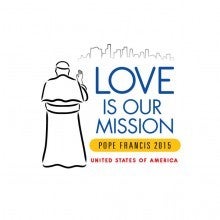
Here on this page, you will find photos, videos, resources, the text of speeches, and other special moments from Pope Francis' 2015 visit to the United States.
Virtual Pilgrimage (PDF)
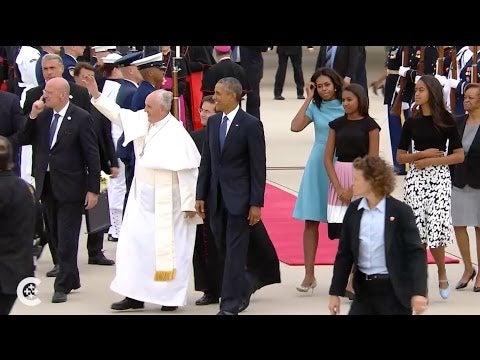
Pope Francis visits America
Complete Catholic News Service video coverage of the historic visit to the United States by Pope Francis in September 2015.
9 Ways People Participated in Pope Francis's 2015 US Visit
Hundreds of Thousands saw Pope Francis when he visited the US in September, 2015. Here are the some of the ways those who did not get to see him in person "virtually" participated in the events.
- Took part in a "Virtual Pilgrimage" with these prayers as the Holy Father made his way to more than a dozen different locations in Washington, DC, New York City, and Philadelphia.
- Learned about the places Pope Francis visited by following his journey on this interactive map .
- Become "Pope Francis literate" by reading his two encyclical letters: Lumen Fidei and Laudato Si
- Stayed up-to-date and read insightful commentary by connecting with the only news source founded and supported by the US Bishops, Catholic News Service . See the latest in the CNS feed below.
- Held a Papal Visit Watch Party using the USCCB live stream in English with audio commentary here or watched video on demand .
- Received the latest est papal visit news and more by downloading the Catholic Church app. Responded to Pope Francis's call to enounter by reaching out to those in need, supporting parish or community charitable efforts, acting to promote life, human dignity, families and religious freedom, and by caring for creation.
- Invited a non-Catholic or non-practicing Catholic friend to Mass following the pope's visit.
- Engaged in the USCCB's award-winning social media effort with the hash tags #PopeinUS and #PapaEnUSA.
- Supported the many people who worked to make Pope Francis' historic US visit a success by praying for them to the Blessed Virgin under her title Mary, Undoer of Knots (a favorite of Pope Francis).
Liturgical Texts for Masses and Prayer Services
Media guide, resources, speeches, and homilies, papal-visit-2015-pocket-media-guide.
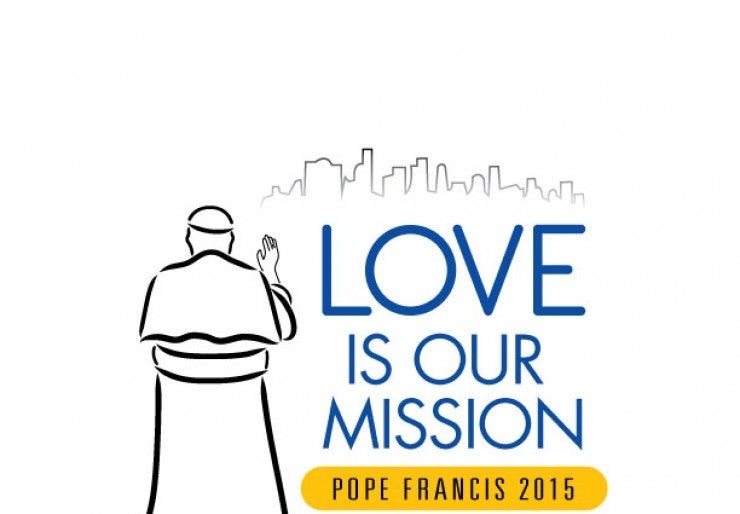
Papal-Visit2015-Media-Resources
Wednesday-9-23-mass-canonization-serra, wednesday-9-23-midday-prayer-st-matthew, thursday-9-24-vespers-st-patrick, friday-9-25-multi-religious-ground-zero, friday-9-25-mass-madison-square-garden, world-meeting-families-2015-congress-liturgies, papal-mass-program-sunday-9-27-15, papal-mass-program-saturday-9-26-15, papal visit speeches and homilies, wednesday, september 23, 2015.
- White House Welcome Ceremony, speech
- St. Matthew's Cathedral, Midday Prayer with US Bishops,homily
- Basilica of the National Shrine of the Immaculate Conception Square, Holy Mass of Canonization, homily
Thursday, September 24, 2015
- United States Capitol, Visit to US Congress, speech
- St. Patrick's Parish (Washington, DC), Encounter with the Poor, speech
- St. Patrick's Cathedral (New York, NY), Vespers, homily
Friday, September 25, 2015
- United Nations, Meeting with UN Staff, speech
- United Nations, UN General Assembly, speech
- Ground Zero Memorial, Interreligious meeting, speech
- Harlem School, Meeting with Immigrant Families and Children, speech
- Madison Square Garden, Holy Mass, homily
Saturday, September 26, 2015
- Cathedral of St. Peter & Paul, Holy Mass, homily
- Independence National Park, Religious Liberty Meeting, speech
- Benjamin Franklin Pkwy., Festival of Families, speech
Sunday, September 27, 2015
- Meeting with Victims of Sexual Abuse
- St. Martin of Tours Chapel, Meeting with WMOF Bishops, speech
- Curran-Fromhold Penitentiary, Meeting with prisoners, speech
- Benjamin Franklin Pkwy., Holy Mass (WMOF Closing Mass), homily
- Atlantic Aviation (PHL Airport), Greeting of WMOF Organizers, speech
Catechetical Resources
- Pope Francis for Children ( Español )
- Pope Francis for Adults ( Español )
- Blessed Junípero Serra ( Español )
Children’s Activities
- Please Pray for Me – Coloring Sheet
- Blessed Junípero Serra – Facebook Page ( Español )
- Coat of Arms Project ( Español )
Prayer Resources
- Prayer of Anticipation ( Español )
Info Sheets
- Saints Among Us in the Archdiocese of Washington ( Español )
Lesson Plans
- Who Was Peter? ( Español )
- Who is Pope Francis? ( Español )
- What is the Mission of the Pope? ( Español )
- Why is this Visit Important? ( Español )
Grades 9-12
Adults catechesis on pope francis.
- 3 Lessons ( Español )
Papal Visits to the United States
Pope Francis was the fourth pope to visit the theUnited States. His apostolic journey to the United States took place from September 22-27, 2015, and he visited Washington, New York and Philadelphia. Pope Francis' visit was the tenth time a pope made an apostolic journey to the United States.
Other pastoral visits from previous popes are:
Pope Benedict XVI visited the United States in 2008. His apostolic visit, April 15-20, took him to Washington and New York.
Pope John Paul II visited the United States seven times:
- 1979 (10/1 – 10/7) Boston, New York, Philadelphia, Chicago, Washington and Des Moines, Iowa.
- 1981 (2/27) Anchorage, Alaska – stopover/several hours
- 1984 (5/2) Fairbanks, Alaska – stopover/several hours
- 1987 (9/10 – 9/19) Miami, Columbia, SC, New Orleans, San Antonio, Phoenix, Los Angeles, San Francisco, Detroit
- 1993 (8/12 – 8/15) Denver (World Youth Day)
- 1995 (10/4 – 10/8) Newark, NJ, New York (including Brooklyn), Baltimore
- 1999 (1/26 – 1/27) St. Louis
In October 1965, Paul VI became the first pope to visit the United States. His trip included a first time papal visit to the United Nations.
Pope Francis was the fourth pope to meet with a U.S. president during a visit to the United States. Other popes who have met with a U.S. president during a U.S. visit are:
Pope Benedict XVI:
- April 16, 2008, on the occasion of Pope Benedict XVI's 81st birthday, President George W. Bush welcomed Pope Benedict to the White House. This was the second time in history that a pope visited the White House.
Pope John Paul II met with a U.S. president during each of the following visits to the United States:
- 1979 – President Jimmy Carter (The White House, Washington)
- 1984 – President Ronald Reagan (Fairbanks, Alaska: first time a U.S. president and pope met outside of the White House or Vatican)
- 1987 – President Ronald Reagan (Los Angeles)
- 1993 – President Bill Clinton(Denver)
- 1995 – President Bill Clinton (Newark, NJ)
- 1999 – President Bill Clinton (St. Louis)
Pope Paul VI:
- 1965 -- President Lyndon Johnson (New York City)
Pope Francis' visit to the United Nations was the fourth time a pope addresses the United Nations while visiting the United States.
Pope Francis
- United Nations Headquarters (New York),September 25, 2015
Benedict XVI
- United Nations Headquarters (New York), April 18, 2008
John Paul II
- United Nations Headquarters (New York), October 2, 1979
- United Nations Headquarters (New York), October 5, 1995
Pope Paul VI
- United Nations Headquarters (New York), October 4, 1965
*Sources: www.usccb.org , Vatican.va
- International edition
- Australia edition
- Europe edition

Fifty years of papal visits to the United States
How the Guardian reported papal tours of America over the past half-century
- Pope Francis journeys to Washington to begin historic US visit
- Have you met the pope? Share your experiences
Fifty years after the first papal visit to the US, Pope Francis makes a three-city tour of the country which includes attending the World Meeting of Families in Philadelphia.
The first reigning pontiff to visit the United States was Pope Paul VI, who made a one-day stop in New York to address to the United Nations in 1965. Here he called on the UN to declare ‘ no more war .’

The Guardian’s response to the speech was to be found in the editorial, Peace-loving is not enough . Elsewhere in the paper, Hella Pick noted that the Pope’s long handshake and seemingly friendly conversation with the Soviet foreign minister was subject to wide comment. Meanwhile, when the pope celebrated mass at the Yankee Stadium, Alistair Cooke reported that the ‘great, garish pit [was ] translated overnight into a circular cathedral.’
Fourteen years later, Pope John Paul II made the first of seven visits to the US.

After a 2,300 mile tour of America that included a visit to Harlem and a speech endorsing the conservative line on sex issues , Pope John Paul II became the first pontiff to visit the White House.
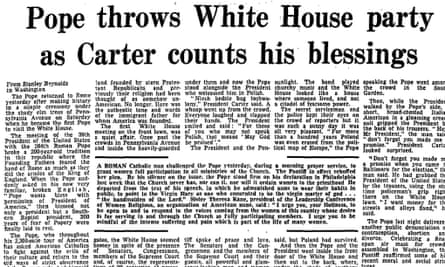
Other visits included a stopover in Fairbanks, Alaska in May 1984 , where he met President Ronald Reagan.
In 2008, Pope Benedict XVI visited Washington and New York. Making his first visit to the US since his election in 2005, he was greeted on the White House lawn by the president, George Bush, plus a 21-gun salute and a serenade from a world-class opera singer.
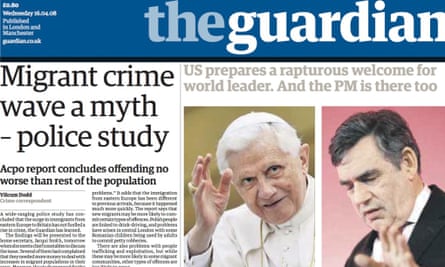
The 265th pope gave a resounding endorsement of the role of religion in democratic society telling a crowd of thousands that ‘the need for global solidarity is as urgent as ever’ in an age of extremism and terror. The following day he addressed the UN general assembly .
Visiting the US at the same time was Gordon Brown, the British prime minister, but, as Stephen Bates noted, he was never going to dominate the news agenda as ‘ passing popes will always outrank prime ministers .’

- Pope Francis
- From the Guardian archive
- Catholicism
- Christianity
Comments (…)
Most viewed.
The New York Times
Live coverage | highlights of pope francis’ visit to the united states, highlights of pope francis’ visit to the united states.
By The New York Times September 23, 2015 September 23, 2015
A Whirlwind Papal Journey Concludes
- The crowded agenda of the Pope’s first visit to the United States ended in Philadelphia, where he met with victims of sexual abuse, spoke to inmates and celebrated a Mass in the heart of the city.
- Sunday culminated a six-day, three-city tour , where, in his public appearances, he continued to call for unity and underscore the importance of family.
- While hundreds of thousands of people were moved by the opportunity to pray with the pope, he left America with a blessing and his signature request: “Pray for me.”
So Long, America

One More Embrace: ‘God Bless America’
I embrace all of you in the Lord and I entrust you to the maternal care of Mary Immaculate, Patroness of the United States. I will pray for you and your families, and I ask you, please, to pray for me. May God bless you all. God bless America!
– Pope Francis, in final remarks before returning home
This Land is Blessed
This land has been blessed with tremendous gifts and opportunities. I pray that you may all be good and generous stewards of the human and material resources entrusted to you.
– Pope Francis, in final remarks before returning home.
A Final Ode to Family
I pray that our days of prayer and reflection on the importance of the family for a healthy society will inspire families to continue to strive for holiness and to see the Church as their constant companion, whatever the challenges they may face.
– Pope Francis, in final remarks before heading home
Mass Concluded, Pope Francis Makes Way to Airport

Pope Francis headed to the airport, having concluded the final and largest Mass of his trip.
He continued to touch on themes of unity and family in his last homily and thanked the crowd of thousands who gathered to pray with him in Philadelphia.
“Thank you very much for your participation and for your love of family,” Francis said. “And I ask you pray for me. Don’t forget.”
The pope has one more public appearance to make before his plane takes off. He will be greeted by Vice President Joseph R. Biden Jr. as well as organizers and volunteers of the World Meeting of Families event at the airport.
A Baby Is Blessed, and a Mother Is Overcome
Narcisa Chuquirima only wanted to see Pope Francis. That would have been more than enough.
She had traveled to Philadelphia from Newark with her husband, her daughter and two of her four sons, including four-month-old Noah Gabriel. They were part of a group from St. Aloysius Parish that had come to participate in the weekend’s events.
“To see him is a blessing,” she said.
At about midday on Sunday, the group – numbering about 230 and wearing matching dark blue T-shirts – made their way through the streets of downtown Philadelphia, passed through the security perimeter and, despite the tens of thousands who had already poured into the area, somehow found a large patch of empty grass along the police barricades lining Benjamin Franklin Parkway.
“It was ready for us,” said Ms. Chuquirima, 37, a daycare worker and an Ecuadorean immigrant like her husband Amable Chuquirima, 44. They laid out cardboard and plastic sheeting and got comfortable, hoping that they had correctly guessed the pope’s route to the Mass.
As they waited, Ms. Chuquirima, came up with a plan: Should the pope drive by, she told her group, everyone should yell the pope’s name in unison in the hope he might turn to them.
At about 3:30 p.m. they heard the distant roar of the crowd, and that sound swept closer like an approaching storm, tracking the movement of the pope’s convoy – a thunderous wave of adulation.
It was headed toward their spot of grass. Ms. Chuquirima lifted Noah Gabriel, in his baptism clothes of a white singlet and white beanie, into her arms.
The popemobile came into view, and the group saw a member of the pope’s security detail carrying a baby to the pope for a blessing.
Ms. Chuquirima allowed herself a thought: Maybe they would also pick Noah Gabriel.
“But I didn’t think he would stop,” she recalled. She kept yelling and whistling all the same. “Papa! Papa!” she hollered, using the Spanish word for pope.
Francis was looking in the other direction as he drew abreast of the group but one of his security guards spotted Noah Gabriel and headed toward him.
“As he got close, my legs started shaking,” Ms. Chuquirima recalled. “Even as I tell the story now, my legs are shaking.”
The baby was lifted from her arms and, overwhelmed with emotion, she clutched the guardrail to prevent herself from collapsing. “I was yelling and crying, saying, ‘God loves me. God loves me.’ I feel like God touched me, he gave me his hand.”
She was so overcome with emotion, she was unable to see what happened next: The security guard carried Noah Gabriel to the pope, who touched and kissed his head. The group from San Aloysius Church was ecstatic.
Moments later, the baby was back in his mother’s arms.
“I felt like my son was an angel,” Ms. Chuquirima said. Still overwhelmed by the memory an hour and a half after the event, she started crying once again. “It’s a blessing for our family, for our parish. I feel like God chose this baby, to be a martyr, to be something special.”
“We feel like he’s going to save us from the waters, from the high tides,” said Ms. Chuquirima’s daughter, Jeannie, 14.
“We’re a very humble family,” Mr. Chuquirima, a carpenter, added. “We work day in and day out to support the family. It was a real blessing.”
Pope Francis Seen as Inspiring Outreach to the Vulnerable

Bishop Edward J. Burns of Juneau, Alaska, said of Francis’ visit, “It was not only a home run. It was a grand slam.”
He said in an interview that it was inspiring to see the pope reach across barricades to embrace people in need and people who are suffering.
“He stops and reaches out to those who suffer, and it’s an example and a model for us as bishops as well,” he said.
Praying with the Pope

On Overcoming Evil

Anyone who wants to bring into this world a family which teaches children to be excited by every gesture aimed at overcoming evil – a family which shows that the Spirit is alive and at work – will encounter our gratitude and our appreciation.
– Pope Francis, in the homily at his final Mass in Philadelphia
Love Is the Little Things
Love is shown by little things, by attention to small daily signs which make us feel at home. Faith grows when it is lived and shaped by love. That is why our families, our homes, are true domestic churches.
– Pope Francis, in his homily at a final Mass in Philadelphia
An Openness to Faith

Jesus encountered hostility from people who did not accept what he said and did. For them, his openness to the honest and sincere faith of many men and women who were not part of God’s chosen people seemed intolerable.
Pope Francis, in his homily at a final Mass in Philadelphia
Live Video of the Mass on Benjamin Franklin Parkway

Pilgrims Pack Streets as Pope Rides to Mass

Hundreds of thousands of pilgrims packed the long boulevard leading to the makeshift sanctuary where Pope Francis is celebrating the concluding Mass of the World Meeting of Families on Benjamin Franklin Parkway.
Waving Mexican, Argentine, Vatican and other flags from around the world, the throng cheered as the pope, standing in his popemobile, took a spin around the boulevard, blessed babies and, as the choir struck up with “hallelujah,” climbed out to meet the people pressed against the gates.
Victims Suggest Church Is Shifting Debate on Abuse
The five victims of child sexual abuse who met with Pope Francis on Sunday morning included some who had been abused by relatives or educators, not Roman Catholic clergy — a deliberate decision made to show that the church is taking a “larger perspective” on the problem of sexual abuse, said the Rev. Federico Lombardi, a Vatican spokesman.
Victims of clergy sex abuse and their advocates saw something less benign at work: a subtle but unmistakable effort by the Vatican to shift the terms of the debate, to show “that it’s not always the church’s fault,” as Marci A. Hamilton, a law professor at the Benjamin N. Cardozo School of Law at Yeshiva University who has represented hundreds of victims of clerical sexual abuse, put it.
Church officials have argued that sexual abuse of children is not confined to the Catholic Church, pointing out that it infects other institutions and other religions as well. The pope may not have explicitly said the same, the advocates said, but the meeting’s inclusion of people abused by teachers and relatives as well as priests spoke volumes.
“He almost seems to be trying to deflect attention somewhere else,” said Barbara Blaine, the president of the Survivors Network of Those Abused by Priests, the country’s most prominent support and advocacy group for victims of clergy sexual abuse. “Of course those who are sexually violated suffer horribly, regardless of who the perpetrator is. But the problem that we see is that we think Pope Francis has both the authority and the responsibility to stop the sexual violence in the church, and he’s failing to do that.”
The Italian Feast That Could’ve Been
While “thrilled” that the pope stopped at St. Joseph’s University, the Rev. Philip Florio was disappointed that Francis did not add a visit to Old St. Joseph’s Church to his itinerary.
“I’m admittedly disappointed that he didn’t stop here,” Father Florio said, noting that his parish is the oldest Catholic church in Philadelphia.
“Besides, as an Italian-American I would’ve had ravioli, meatballs and Italian sausage waiting for him,” he said. “It’s a Sunday after all, and he’s of Italian heritage. We usually have a big Sunday meal!”
Smile for the Smartphones

Sydney Archbishop Reflects on Call to Strengthen Family Ties
Pope Francis’ call on Sunday morning for bishops to strengthen their familial ties did not go unnoticed.
Anthony Fisher, the archbishop of Sydney, Australia, who was in town for the events, said the speech gave him plenty to reflect upon.
“I think it’s interesting that he was insisting that we had to rebuild or renew our covenant with families, suggesting that we maybe weren’t as close to families as we should be as bishops, and there is an important challenge in that for us to reflect on,” he said. “Is it the case that we are too far removed from our families and their lives?”
He also addressed he pope’s message about the challenges of living within modern society.
“I think it has been a message of his on several occasions, including when he addressed the U.S. bishops, about not always being in contest, not approaching family life always with a critique of what’s wrong with the world, the way families are in the world today,” he said.
When asked if he had heard much of a critique from the pope about social issues including same-sex marriage, the archbishop said, “No. Well, he’s touched on them but very gently and I think that’s — he’s probably modeling what he is calling the bishops to when he is saying to not be permanently in a posture of contest with our surrounding culture. That seems to be what he is proposing to us.”
The archbishop said the pope seemed to be asking “whether he thinks something more friendly and dialogical relationship rather than what people have called the culture wars is more likely to win hearts and minds.”
On Sale This Fall: The Pope’s Greatest Hits
You’ve seen the tour, now you can buy the album.
As The Times has reported, the pope is scheduled to release an album called “Wake Up!” on Nov. 27, after his whirlwind United States trip, during which he has been greeted by hundreds of thousands of well-wishers. The album features the pope’s speeches set to rock, pop and Gregorian chants, and will raise money for a support fund for refugees.

Next Up From Pope Francis? An Album, of Course
By ANDREW R. CHOW
After his whirlwind United States tour, Pope Francis will release a Vatican-approved album, which features his speeches set to rock and sacred music.
Cheers From Students at St. Joseph’s University
Cheers erupted from a crowd of several hundred people, mostly students, when the pope’s Fiat arrived on the campus of St. Joseph’s University, a Jesuit university in Philadelphia.
The stop, announced publicly only shortly before he arrived, allowed for the most famous member of the Jesuit religious order to honor fellow Jesuits who were hoping for such acknowledgment. On other trips abroad, Francis has visited his Jesuit brothers.
On the edge of a campus lawn, the pope greeted the well-wishers, many of whom carried cellphones to record the event.
In a nod to his frequent outreach to those practicing other faiths, a highlight of his stop at the university was to view a newly installed statue that commemorates the tie between Catholic and Jewish faiths.
The statue, “Synagoga and Ecclesia in Our Time,” was created by Joshua Koffman, a local artist, and dedicated last week. According to the University, the statue was erected to commemorate “the 50th anniversary of Nostra Aetate, the Vatican II document that transformed the relationship between the Catholic and Jewish faiths.”
As he blessed the statue, he was joined by an old friend and fellow Argentine, Rabbi Abraham Skorka.
The trip lasted less than 10 minutes, and ended with the pope waving good-bye from the back of his car.
. @Pontifex is on our campus? Is this real life? pic.twitter.com/tr7cuhTIuE — Saint Joseph's (@saintjosephs) September 27, 2015
Awaiting Final Mass, Pope’s Message Resonates
Susan McNeil, the director of Marriage and Family Life at the Archdiocese of Milwaukee, was carrying a folding chair towards the Benjamin Franklin Parkway, where Francis would give his final mass in America later in the day. She said that she took Francis’ advice in his speech to bishops earlier in the morning to heart.
“He told them embrace families,” said Ms. McNeil, an attendee of the World Meeting of Families here. “It’s a reminder and we all need a reminder now and then. When you are a bishop you have a lot of meetings and governance, I know our bishop is very busy. It’s a reminder not to forget why I’m there.”
Her friend, Grace Urbanski, the director of Apostleship of Prayer, a children’s ministry in Milwaukee, called Francis the “pastor of the U.S. parish.” And said that her own priest often dined in the homes of his parish’s families to stay grounded in the real challenges they faced. She said “bishops don’t get that chance. They are invited to a lot of fancy dinners” and had last chance to get “messy.”
Asked about the pope’s reemphasis on “appreciation” over “complaints” of the family, on a pastoral approach instead of reiterating doctrine, Ms. McNeil said “it a both, and situation.” She said “none of us meet the ideal” and the mission is to “continue to draw them closer to us and not push them away.”
“It’s come as you are, but don’t stay there,” said Ms. Urbanski.
Pope Francis Visited Washington
Here's what you need to know.
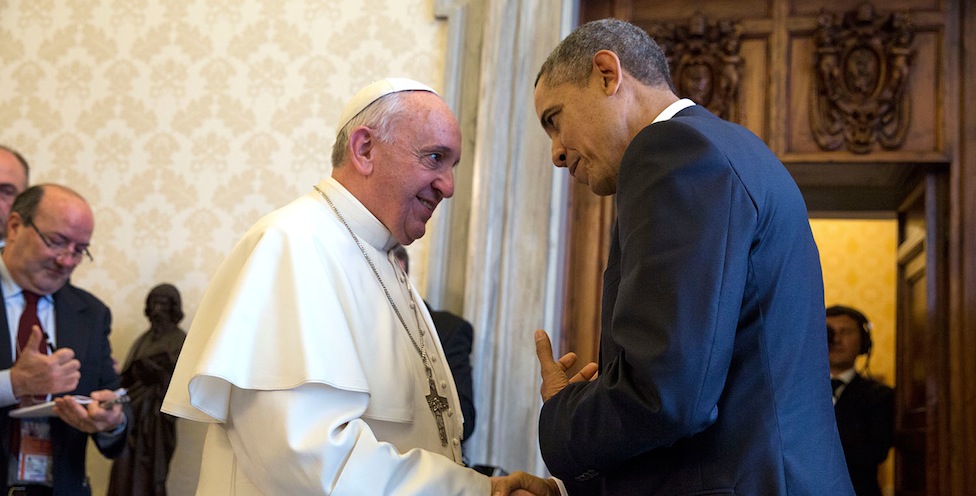
Watch some of the top videos of the Pope's visit:
Share this page with your network:
FACEBOOK TWITTER
Follow Along with the Pope's Trip
See photos of the visit..
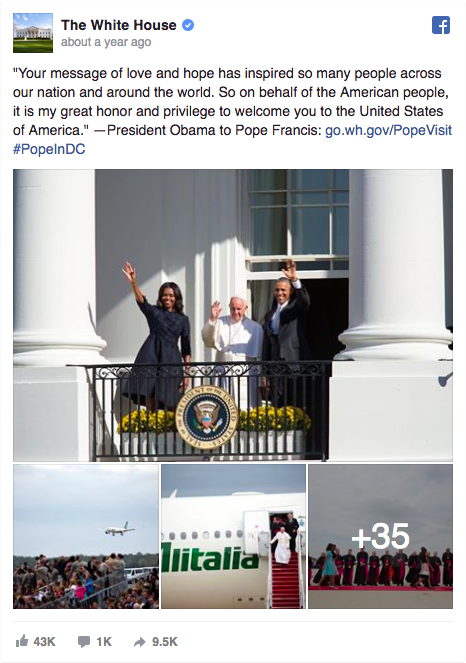
Words from Pope Francis:
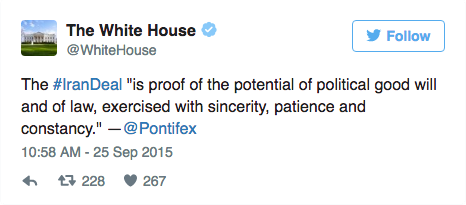
From the arrival ceremony:
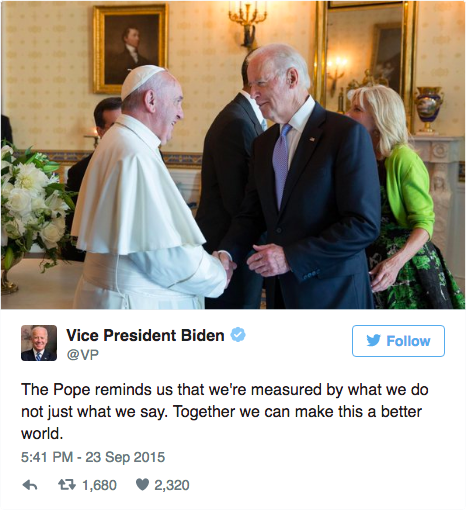
From the arrival ceremony setup:
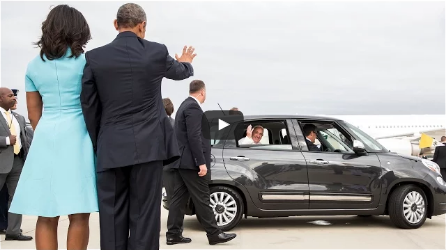
A digital exchange between President Obama and Pope Francis:
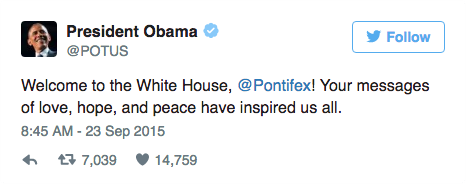
Pope Francis arrives in the United States:
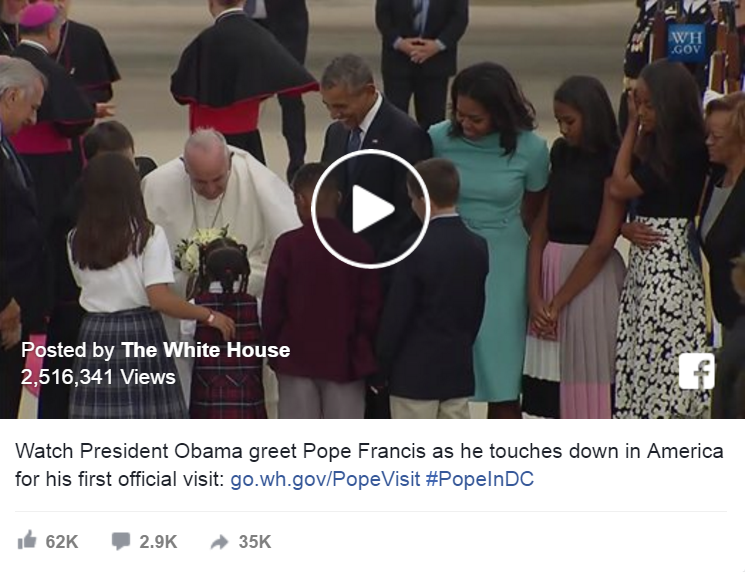
The Schedule
For up-to-date information about road closures and security announcements for Washington, D.C., New York, and Philadelphia, please visit www.secretservice.gov/events/pope/ .
Tuesday, September 22, 2015
4:00 PM:
Pope Francis arrives in D.C. at Joint Base Andrews.
Wednesday, September 23, 2015
White House Arrival Ceremony and personal meeting with President Obama (watch it live here at WH.gov/popevisit).
The White House Arrival Ceremony is not open to the public. Guests must have a ticket to attend.
Following the Pope’s meeting with the President, he will tour the Ellipse and parts of the National Mall.
There are no tickets required for the papal parade, but security around the secure area will be strict. Gates will open at 4 a.m. and close promptly at 10 a.m. after which no one will be allowed in the secure area. For more information on the parade route and access, visit the Archdiocese of Washington's website here .
There will be four entrances to the parade viewing area, including:
- East of the Ellipse on Constitution Avenue
- West of the Ellipse on Constitution Avenue
- East of the Washington Monument near Jefferson Drive and 15th Streets NW
- West of the Washington Monument near 17th Street NW
Midday Prayer with U.S. bishops at Saint Matthew’s Cathedral in D.C.
This event will be closed to the public
Junipero Serra Canonization Mass at the Basilica of the National Shrine of the Immaculate Conception.
Tickets to the Mass will be distributed through local parishes. The Catholic University Campus will be closed to members of the public during the Mass.

Thursday, September 24, 2015
Speech to the Senate and House of Representatives (Joint Session of Congress). The speech will be broadcast live on jumbotrons on the West Lawn of the Capitol.
Visit to St. Patrick’s Catholic Church in D.C. and Catholic Charities of the Archdiocese of Washington
After his visit to St. Patrick’s Catholic Church in D.C. and Catholic Charities of the Archdiocese of Washington, the Pope will travel to New York.
Departure for New York from Joint Base Andrews (D.C.)
Arrival at John F. Kennedy International Airport (New York)
Evening prayer at St. Patrick’s Cathedral (New York)
Friday, September 25, 2015
Address to United Nations General Assembly
Multi-religious service at 9/11 Memorial and Museum at the World Trade Center
Visit to Our Lady Queen of Angels School in East Harlem
Papal motorcade through Central Park
Madison Square Garden Mass
Saturday, September 26, 2015
On the morning of Saturday, September 26 to the Pope will travel from New York to Philadelphia, the final stop on his trip to the United States.
Departure for Philadelphia from John F. Kennedy International Airport
Arrival in Atlantic Aviation hangar at Philadelphia International Airport Philadelphia
Mass at Cathedral Basilica of Sts. Peter and Paul
Visit to Independence Mall
Visit to Festival of Families at Benjamin Franklin Parkway and Prayer Vigil with World Meeting of Families.
Access to certain areas of the parkway will require tickets, but tickets are not necessary to attend this day’s events. Forty jumbotrons, located down the Benjamin Franklin Parkway and other locations in the city, will show the events live, including the public coverage of Pope Francis. For more information about attending this event, visit their website here .
Sunday, September 27, 2015
Papal meeting with Bishops at St. Martin’s Chapel, St. Charles Borromeo Seminary.
Visit to Curran-Fromhold Correctional Facility. This event will be closed to the public.
Papal Mass for World Meeting of Families
Visit with organizers, volunteers and benefactors of the World Meeting of Families at Atlantic Aviation.
Departure for return to Rome.
Answers to Questions About the Pope's Visit
when will the pope visit the white house, how can i participate in the arrival of the pope at the white house.
- Gates open at 5:30AM and will close promptly at 8:15AM
- Please arrive no later than 6:30AM to guarantee your admission to the event
- There will not be any parking available on the White House complex
- Late arrivals will not be permitted—gates will close promptly at 8:15 AM
- Tickets are required for admission—members of the public will be turned away without an event ticket.
- The event will take place rain or shine
- Lost tickets will not be replaced
- Your event ticket will admit ONE person (children of all ages will need an event ticket to attend)
- Tablets, iPads, Tripods, Monopods, and Camera Sticks
- Large Bags, Backpacks, and Suitcases
- Drones and other Unmanned Aircraft Systems
- Animals other than Service/Guide Dogs
- Bicycles, Folding Chairs, Balloons, Coolers, Glass, Thermal or Metal Containers
- Signs or Flags of Any Kind
- Any Pointed Object(s), Including Pocket Knives
- Strollers and Diaper Bags
- Food, Liquids (water will be provided), Aerosols, Tobacco Products, Lighters, Personal Grooming Items
- Firearms, Ammunition, Fireworks, Laser Pointers, Stun Guns/Tasers, Mace/Pepper Spray, Toy Weapons or Knives of Any Kind
- Any Other Items Determined to be Potential Safety Hazards
Will the Pope’s arrival ceremony be broadcast online?
what will the pope and president obama discuss.
- Caring for the marginalized and the poor
- Advancing economic opportunity for all
- Serving as good stewards of the environment
- Protecting religious minorities and promoting religious freedom around the world
- Welcoming and integrating immigrants and refugees into our communities
I’m a member of the Press. How do I obtain credentials to cover the Pope’s visit to the White House?
where can i watch the pope's visit online, where can i get information about getting around washington, dc during pope francis' visit, generic expanding thank-you banner with share buttons.
You told the President you're in — now let your friends know, too.
Popes in America: 50 Years of Papal Visits
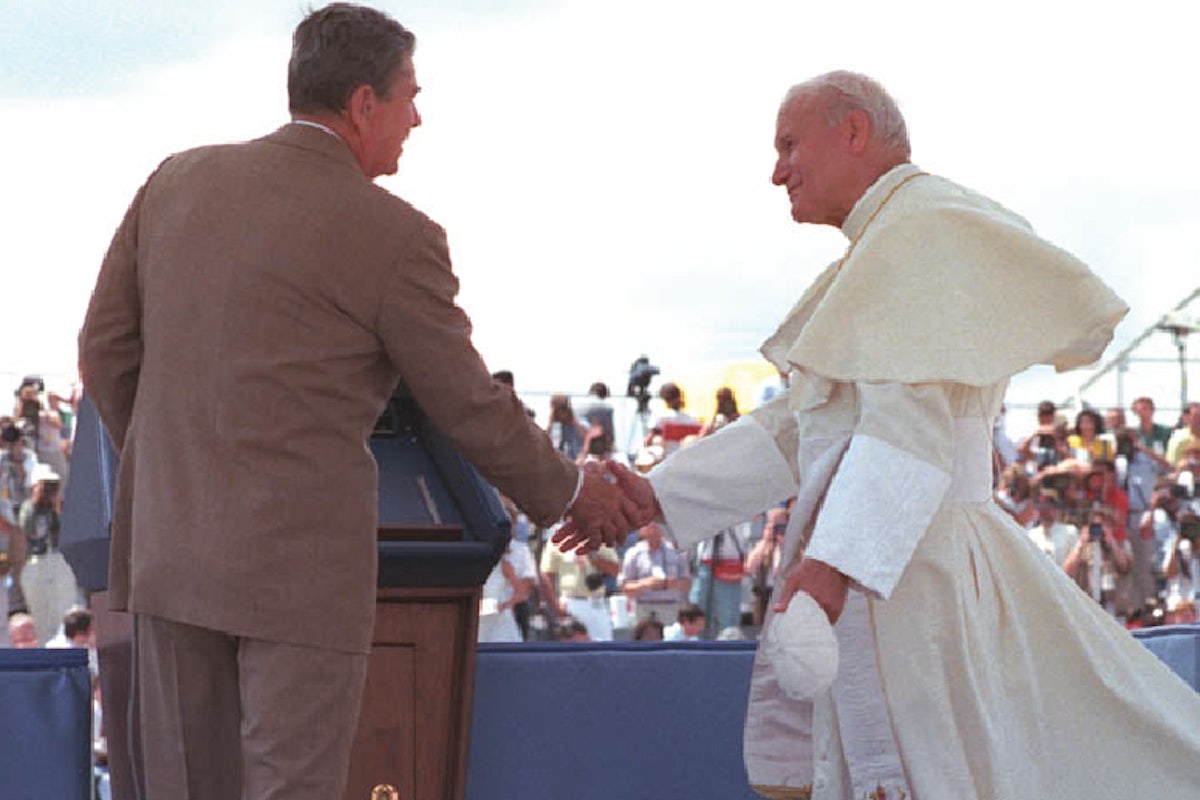
October 4, 1965
Paul vi arrives in new york city : during his visit, he addresses the u.n. general assembly, blesses the new cardinal of new york in st. patrick’s cathedral, and meets with president lyndon b. johnson at the waldorf astoria. his visit lasts a total of 14 hours..
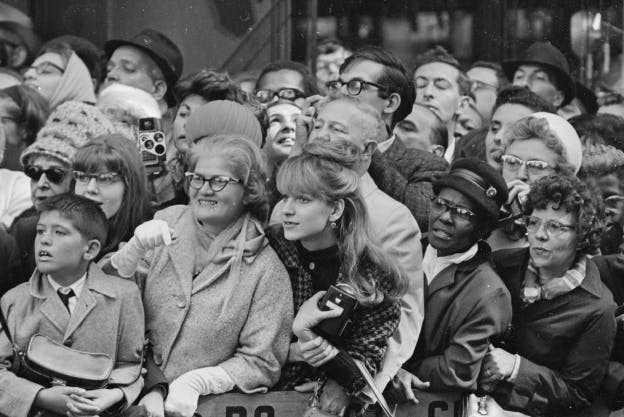
September 21, 1965 The Pope Among Us
"He had come not for us but for the United Nations ... He sounded marvelously innocent of the grounds for quarrel between great nations and, for that reason, the more marvelous for the occasion. Four years ago, the Russians would have darkly searched his text for the ghost of John Foster Dulles; and the Americans would have been wondering whether the Vatican is not a little soft on Communism. Now the United States and the Soviet Union sit together contemplating the barbarities of the Chinese. Pope Paul had fallen perfectly upon the mood of the Assembly and set its key."
September 29, 1979
Pope john paul ii begins his first trip to the united states : he visits boston, new york, philadelphia, chicago, des moines, and washington, d.c., october 20, 1979 popestock in chicago.
"The largest Catholic archdiocese in the United States (2.4 million), the home of the most Polish ethnics (500,000), Chicago probably was more obsessed with John Paul's arrival than any other city. In fact, the city nearly fell victim to its own build-up of the big event, and began to look on Popestock (or "Popefest" as city officials liked to say) with the same enthusiasm it might have for a nuclear accident evacuation."
September 10, 1987
John paul ii begins his fourth trip to the united states : while he made stopovers in alaska in '81 and '84, this is only the second time jpii returns for an extended visit. his stops include miami, columbia, sc, new orleans, san antonio, phoenix, los angeles, monterey, san francisco, and detroit..
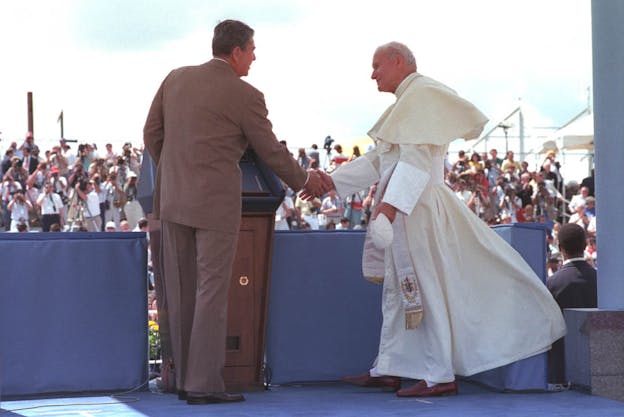
October 5, 1987 Papa Do Preach
"The message of John Paul throughout the American trip was daringly simple: a liberal social and economic activism needs a conservative doctrinal and spiritual base. It's a radical but effortlessly Catholic philosophy, and the importance of the Southwest is that it's the crucible for the experiment. John Paul understands this. He also understands that if it doesn't work here, it won't work anywhere."
August 12, 1993
John paul ii visits denver, colorado for world youth day..
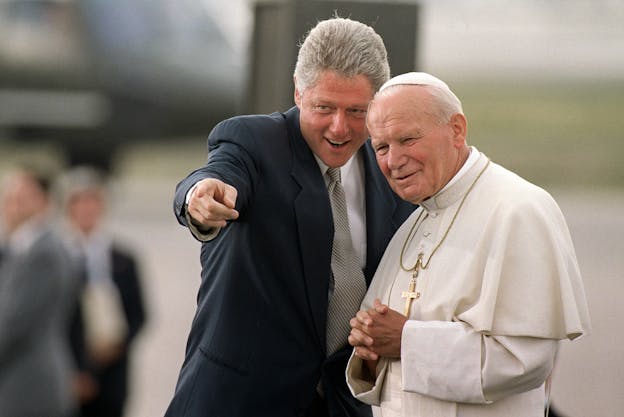
September 6, 1993 John Denver
"All week long, Secret Service helicopters had been flying over our street, scoping out the route to the college where the pope and President Clinton were to meet. T-shirts featuring the pope and the Rocky Mountains were for sale on front lawns fbr blocks around. John Paul—or Juan Pablo, as he was called in this neighborhood—was in town with a vengeance."
October, 1995
John paul ii's sixth visit to the u.s. : he travels to newark, new york, and baltimore, where he celebrates a mass at camden yards..
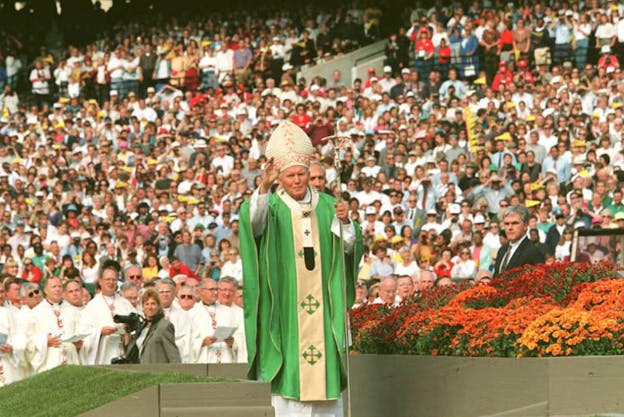
October 30, 1995 Indulgences
"The most politically troublesome thing about the pope's homily in Baltimore was not his obvious reference to abortion...but his declaration that "democracy cannot be sustained without a shared commitment to certain moral truths about the human person and human community." American democracy does rest on moral truths, a whole passel of them, but these truths are rarely legislated ... A very catholic country can never be a very Catholic country. "
January, 1999
John paul ii's seventh and final visit to the united states : he heads to st. louis for the closing of the special assembly for america of the synod of bishops, a papal advisory body., april, 2008, pope benedict xvi's first and only visit to the united states : he meets with president george w. bush, visits ground zero, and addresses the u.n. general assembly. he also celebrates masses at nationals park in d.c. and yankee stadium in new york..
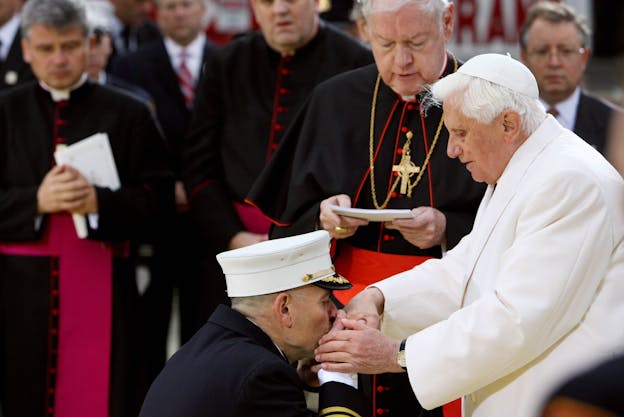
April 9, 2008 Family Values
"If Benedict highlights immigration during his major addresses, Democrats would do well to take notes. The pope's pro-family stance is extremely resonant with Latino voters ... Fine-tuning the Democratic appeal to Latinos could represent quite the electoral trove in November: Latinos have turned out in record numbers for the 2008 primaries. ... In contrast to the harm the Church inflicted on Kerry, this surely counts as papal absolution."
September, 2015
Pope francis arrives in the united states : his schedule includes stops in washington, d.c., philadelphia, and new york city, as well as a meeting with president obama..

- Newsletters
Site search
- Israel-Hamas war
- 2024 election
- Solar eclipse
- Supreme Court
- All explainers
- Future Perfect
Filed under:
- World Politics
Pope Francis’ US visit, explained
Share this story.
- Share this on Facebook
- Share this on Twitter
- Share this on Reddit
- Share All sharing options
Share All sharing options for: Pope Francis’ US visit, explained
/cdn.vox-cdn.com/uploads/chorus_image/image/47241518/GettyImages-489572568.0.jpg)
Pope Francis is making his first-ever visit to the United States this week, and only the 10th-ever visit by a sitting pope. His trip will take him through DC, New York, and Philadelphia from Tuesday to Saturday. He'll speak at Madison Square Garden and a joint session of Congress.
The pope, particularly in DC, will likely use his visit to raise policy issues from abortion to climate change — the latter of which is already drawing some controversy. His trip speaks to the controversial positions this particular pope has taken, as well as fundamental changes in the makeup of the Catholic Church itself, particularly in the US.
What are the basic details of Pope Francis's visit?
:no_upscale()/cdn.vox-cdn.com/uploads/chorus_asset/file/4082788/GettyImages-462758873.0.jpg)
(Franco Origlia/Getty Images)
The pope's first stop is in Washington, DC, where he arrived on Tuesday afternoon. On Wednesday, he'll lead prayers at St. Matthew's Cathedral and the Basilica of the National Shrine of the Immaculate Conception. He'll also go to the White House on Wednesday, where he'll attend a reception in his honor and meet privately with Obama. He addresses Congress on Thursday.
Thursday evening, the pope will arrive in New York, where he'll say prayers with clergy at St. Patrick's Cathedral. The next morning, the pope will address the UN General Assembly, and then in the evening will attend a Mass held at, of all places, Madison Square Garden.
He'll arrive in Philadelphia on Saturday morning. That day, he'll give mass at Cathedral Basilica of Saints Peter and Paul, address a crowd at the Independence Mall in the afternoon, and attend a festival hosted by Mark Wahlberg at night. On Sunday, he'll naturally attend Mass, but will also meet with bishops and visit the Curran-Fromhold Correctional Facility before flying out in the evening.
Why is the Pope visiting the US now?
:no_upscale()/cdn.vox-cdn.com/uploads/chorus_asset/file/2510126/december_francis.0.jpg)
The simple answer is that he was invited. Speaker of the House John Boehner formally invited the pope to address Congress last March . There are about 51 million Catholics in the United States, making it America's single largest religious denomination . It seemed likely, then, that Pope Francis would visit the US at some point. No pope, however, has addressed a joint session of Congress, which speaks to what makes this pope unusual.
But there's more going on here as well. The demographics of Catholicism in the US are changing, and the pope's visit may be designed in part to look at whether the church is keeping up with those changes.
The church is rapidly losing adherents from the traditional Catholic northeastern base: "12.9% of American adults are former Catholics, while just 2% of U.S. adults have converted to Catholicism from another religious tradition," a 2015 Pew survey found. "No other religious group in the survey has such a lopsided ratio of losses to gains."
At the same time, immigration from Latin America is creating a new Catholic base in the country's southwest. According to Pew's data, 29 percent of American Catholics identified as Hispanic in 2007. By 2014, that figure was up to 34 percent.
"Hispanics make up a larger share of the US Catholic population than they do of almost any other religious group," Pew concludes. "And the data suggest that the Hispanic share of the Catholic population is likely to continue to grow at a rapid pace, since Hispanic Catholics are far younger, on average, than non-Hispanic Catholics."
Francis's challenge, according to New York Times national religion correspondent Laurie Goodstein , is "how to reach these many faces of American Catholicism: the fervent and the fallen-away; the liberals and the traditionalists; the anxious, shrinking white working-class churches in some areas, and underserved largely immigrant churches in others."
However, Goodstein notes, the Church's American leadership is still overwhelmingly white. "Just 28 out of 270 active bishops in the United States are [Hispanic], and only about 7.5 percent of priests identify as Hispanic or Latino ," she writes.
This is part of why many of the pope's addresses in the US will be in Spanish, which is also his native language.
"He knows the face of the church is changing, he knows the country’s Hispanic Catholic heritage, and he knows how important Hispanics are for the future of the church," Archbishop José H. Gómez of Los Angeles told Goodstein.
So the pope's visit comes at a critical moment for the American Catholic Church: Its membership is shifting, but its clergy and leadership aren't keeping pace.
What is the pope going to talk about in the US?
:no_upscale()/cdn.vox-cdn.com/assets/4548807/94324873.jpg)
I have a theory. (Greg Wood/AFP/Getty Images)
The Vatican has not exactly laid out a policy agenda for the visit. But there are a few issues that are likely to come up, and which speak to this pope's particular political priorities as well as his somewhat unique role in American politics.
One likely subject is immigration. He's spoken out on immigration in Europe, exhorting European Catholics to welcome refugees and migrants into their homes. USA Today's Erin Kelly reports that he's "expected to exhort lawmakers to open America's doors to struggling immigrants rather than build bigger fences to keep them out." It's a theme in keeping with the pope's theological emphasis on mercy and love for the suffering, as well the growing Latino population in the American church.
Another is Cuba, the country the pope visited immediately before the United States. He played a critical role in the normalization of US-Cuba relations, serving as a trusted intermediary between the Obama administration and the Castro government. Given that he's made continued improvement in US-Cuba relations a personal priority, it seems likely he'll want to revisit it.
There's also climate change. In June, the pope released an encyclical — "Laudato Si" — calling, among other things, for the world to take "radical" action to head off global warming. Catholic University expert Leslie Tentler told the New York Times that the timing of the encyclical indicated the pope is going to take up the issue while in America. "Obviously he wants to influence opinion in the United States because we’re so large and important and we still pollute so much," she told Times reporter Peter Baker.
What is the political and policy significance of his visit?
:no_upscale()/cdn.vox-cdn.com/uploads/chorus_asset/file/3540302/74067123.0.jpg)
This guy is not happy. (Bill Pugliano/Getty Images)
The pope's famously liberal-seeming positions on climate change, inequality, and immigration are likely to come up, but perhaps so are his more conservative-friendly positions on social issues such as same-sex marriage rights. All of this is expected to come up, and given the fact that Francis has chosen to speak before Congress, it seems that he is not shying away from it.
There's not a huge amount of controversy around this, but there's some. Paul Gosar , a Republican congressman from Arizona, has announced that he'll boycott the Pope's address to Congress over his position on climate change. "When the Pope chooses to act and talk like a leftist politician, then he can expect to be treated like one," Gosar wrote in an op-ed published by TownHall .
Other Republican lawmakers have expressed trepidation about what they expect to be Francis's liberal messages. CNN's Manu Raju reports , "In interviews with CNN, a wide array of GOP lawmakers argued that the pope's message should stay away from the political fights consuming Washington, and many expressed strong disapproval of the fiery views he's espoused since taking over the papacy in 2013."
Raju quotes Sen. James Inhofe (R-IA) as saying, "I think it's totally inappropriate that the Pope is weighing in on all the real sensitive, far-left issues."
Pope Francis has drawn criticism from some elements of the right for some time. Rush Limbaugh , for example, has called the pope a "Marxist," and said that the message of "Laudato Si" is that "every Catholic should vote for the Democrat Party."
This speaks to an unavoidable truth about American politics: In an era of intense political polarization, everyone's actions are seen through a partisan lens — even the Pope's. That's true even though 57 percent of Americans have a favorable opinion of Francis, per YouGov , and only 17 percent have an unfavorable one.
But there has also been controversy around the pope's much more conservative views on abortion and same-sex marriage. For example, the 15,000-person guest list for the White House's pope reception includes LGBT activists and an openly gay Episcopal bishop. Last week, The Wall Street Journal reported that these invitations had offended the Vatican, citing a "senior Vatican official."
Though some subsequent reports say that the official who spoke to the Journal didn't speak for the Vatican, the WSJ story has been shared about 115,000 times on Facebook — hitting a nerve, apparently, in most than just the Vatican.
"I’m sure the pope will make everyone very uncomfortable," Rep. Joseph Crowley, a Catholic Democrat from New York, told the New York Times . "There will be some things that Democrats may not like to hear, and there will certainly be some things, I think, the Republicans will not like to hear."
And there is at least one controversy here that crosses partisan lines. On Wednesday, the pope will canonize Junipero Serra , an 18th-century Spanish missionary who converted thousands of Native Americans — but subjected them to corporal punishment in the process.
Will you support Vox today?
We believe that everyone deserves to understand the world that they live in. That kind of knowledge helps create better citizens, neighbors, friends, parents, and stewards of this planet. Producing deeply researched, explanatory journalism takes resources. You can support this mission by making a financial gift to Vox today. Will you join us?
We accept credit card, Apple Pay, and Google Pay. You can also contribute via
In This Stream
Pope francis’s us visit.
- Why one Republican congressman says he was "disappointed" by Pope Francis
- Pope Francis’s US visit, explained
- Pope Francis's visit to the US begins with stop in Washington, DC
Next Up In World Politics
Sign up for the newsletter today, explained.
Understand the world with a daily explainer plus the most compelling stories of the day.
Thanks for signing up!
Check your inbox for a welcome email.
Oops. Something went wrong. Please enter a valid email and try again.

Will AI mean the end of liberal democracy?

Israel and Iran’s conflict enters a new, dangerous phase
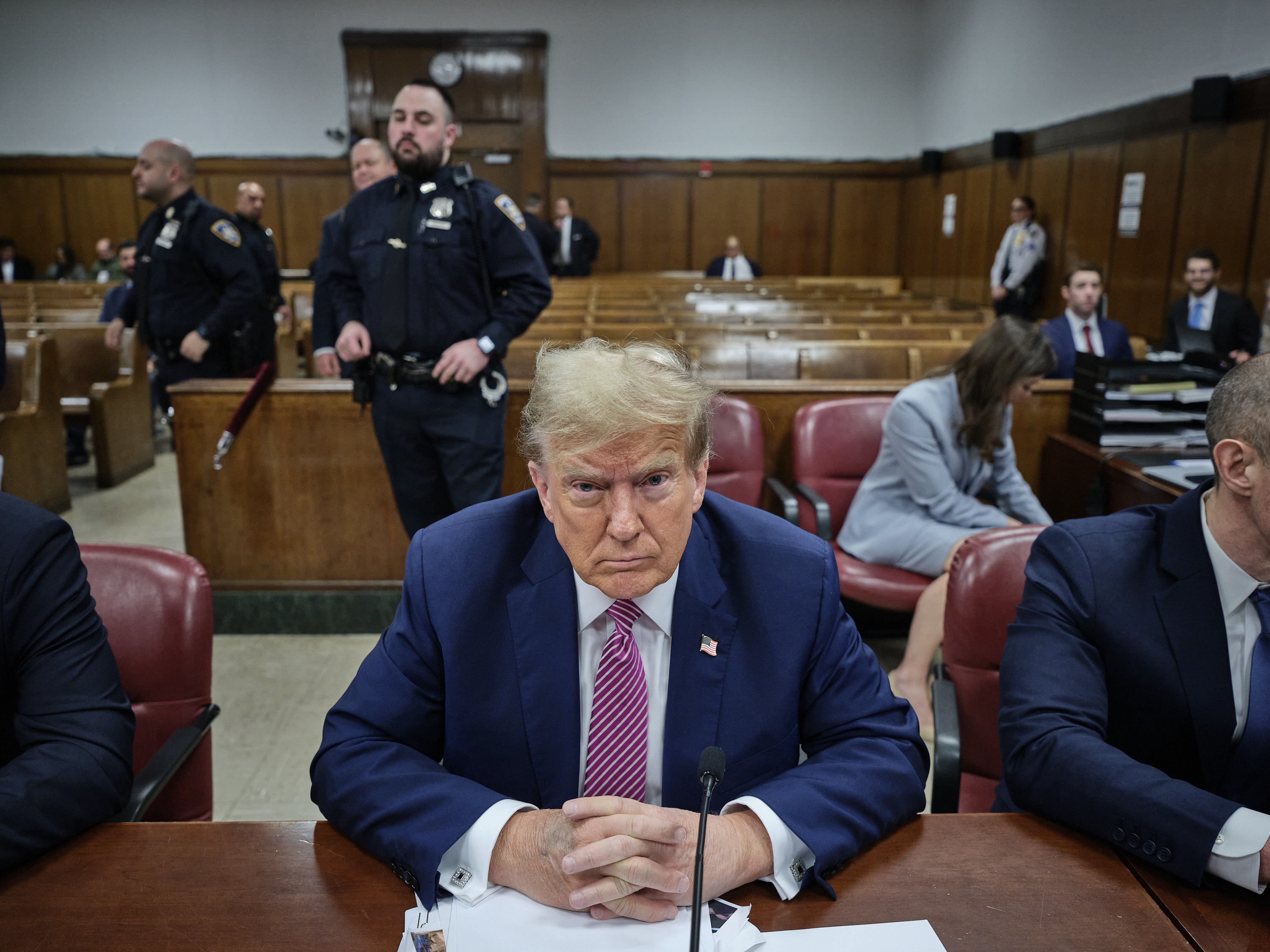
Trump’s jury doesn’t have to like him to be fair to him
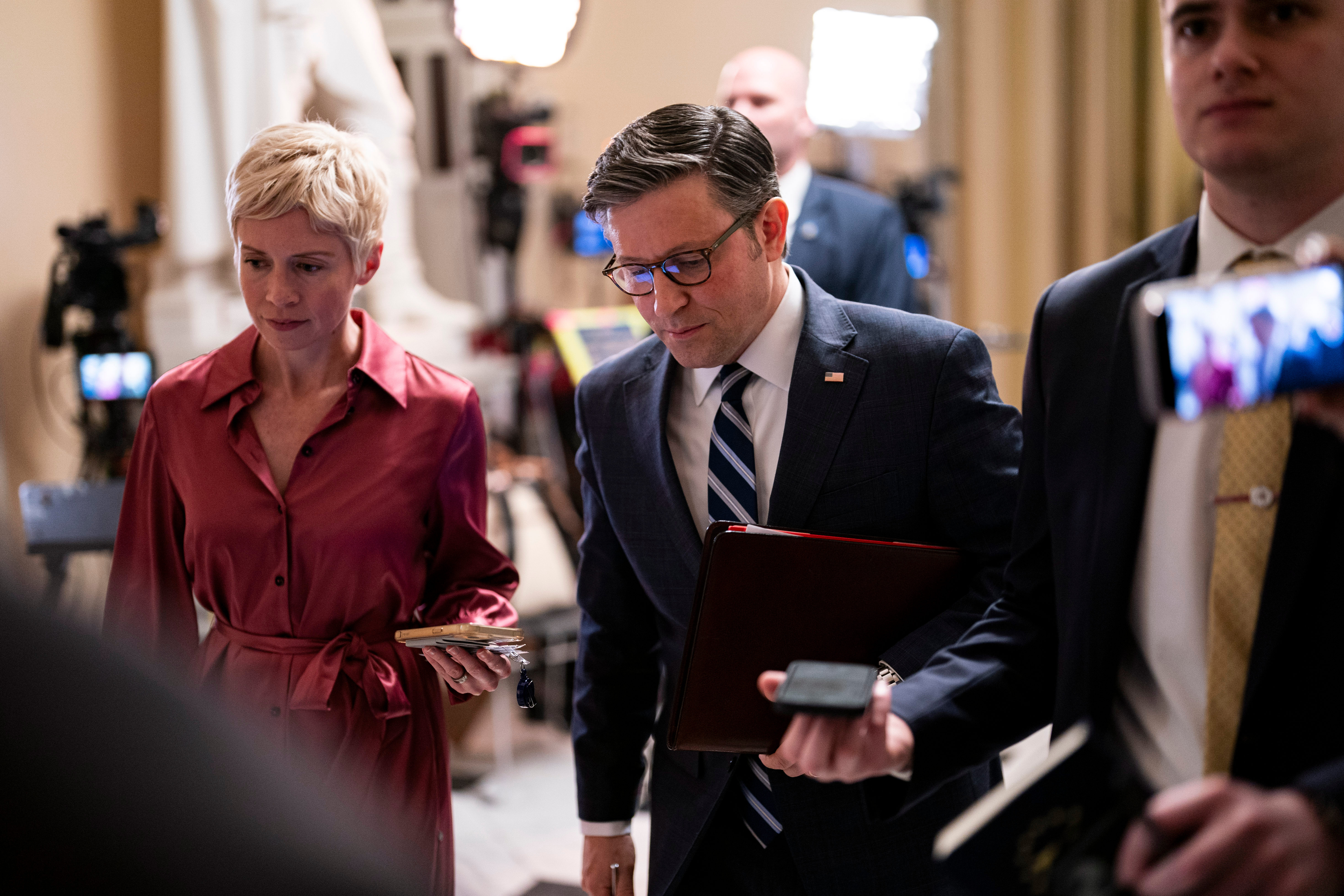
What’s behind the latest right-wing revolt against Mike Johnson

Taylor Swift seems sick of being everyone’s best friend

Are there really more things going wrong on airplanes?
50 Years Of Pope Visits To The United States
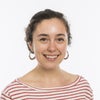
Reporter, HuffPost
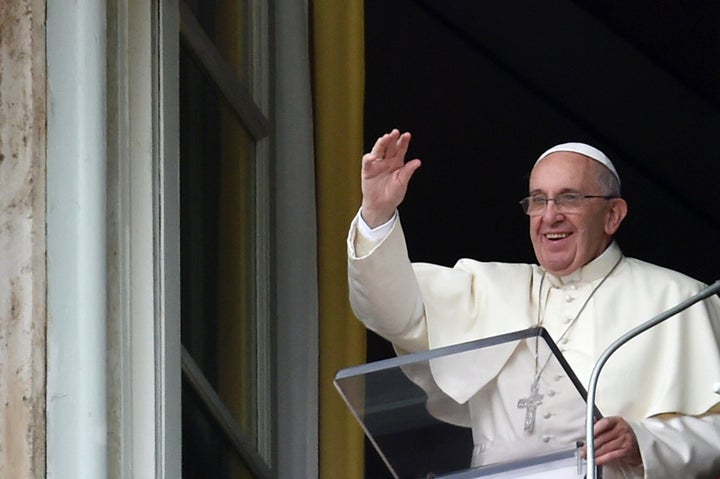
Pope Francis waves to faithfuls gathered in St. Peter's Square following his Sunday Angelus prayer from the window of the pontiff studio on August 16, 2015 at the Vatican.
Pope Francis will make his first visit to the United States in September, with stops in Washington, New York and Philadelphia. His trip will add to the 50-year history of pope visits to the U.S.
Pope Paul VI made the first papal visit to the U.S. in October 1965. He addressed the United Nations General Assembly, attended the New York World's Fair and celebrated Mass at Yankee Stadium. He also met with President Lyndon Johnson.
In October 1979, Pope John Paul II made his first of seven trips to the U.S. He visited Boston, New York, Philadelphia, Chicago and Des Moines, and met President Jimmy Carter in Washington.
In February 1981, John Paul II spent several hours on a stopover in Anchorage, Alaska, after canonizing the first Filipino saint, Lorenzo Ruiz , in Manila. Three years later, he met President Ronald Reagan during another stopover in Alaska, while en route to canonize 103 martyrs in Seoul, South Korea.
John Paul II's longest U.S. visit was in September 1987, when he made stops in Miami; New Orleans; San Antonio, Texas; Phoenix; Los Angeles; Salinas, California; and Pontiac, Michigan. In 1993, he celebrated Mass at World Youth Day and met with President Bill Clinton in Denver.
John Paul II visited New York City, New Jersey and Baltimore in 1995, and met again with Clinton. His final visit was in January 1999, when he celebrated Mass with more than 100,000 people at a football dome in St. Louis.
Pope Benedict XVI visited the U.S. once, in April 2008. He met with President George W. Bush at the White House and visited New York City, where he offered a blessing at the World Trade Center site.
Here's a look back at 50 years of pope visits to the U.S.:
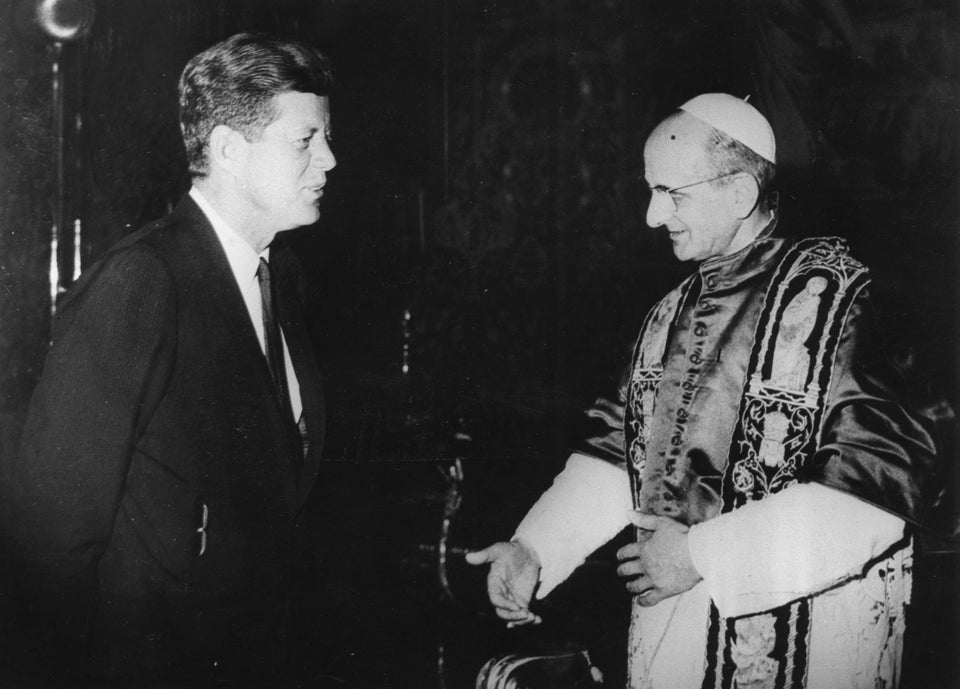
Pope John Paul II gestures to the crowd during his trip to the United States, on Oct. 6, 1979.
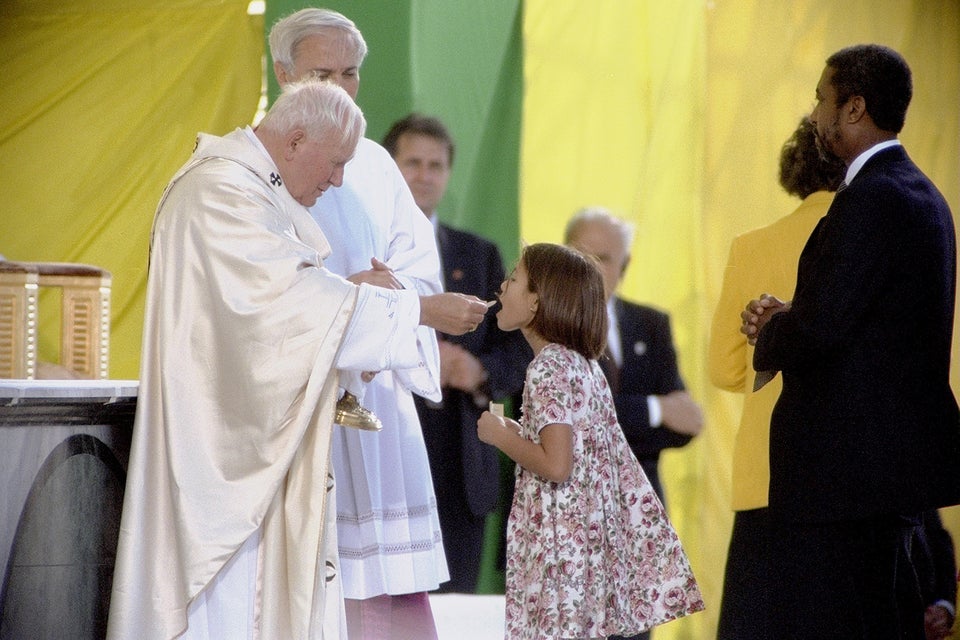
Young girl receives communion from Pope John Paul II as they celebrate Mass at Aqeduct Race Track in Jamaica, Queens, on Oct. 6, 1995.
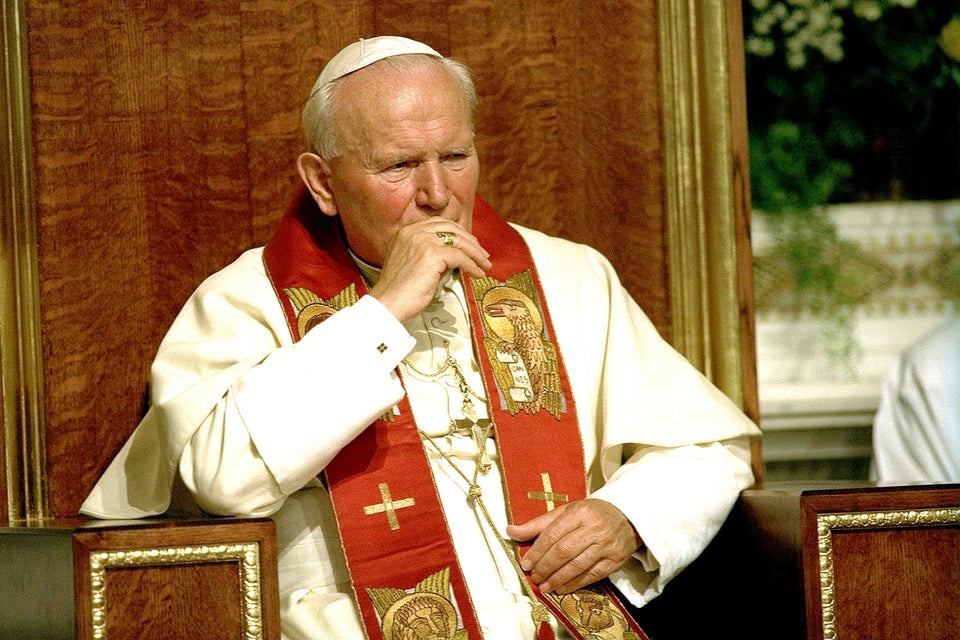
Pope John Paul II says evening prayers in the Chapel of St. Peter and St. Paul at St. Joseph's Seminary in Yonkers, during his 1995 visit to the U.S.
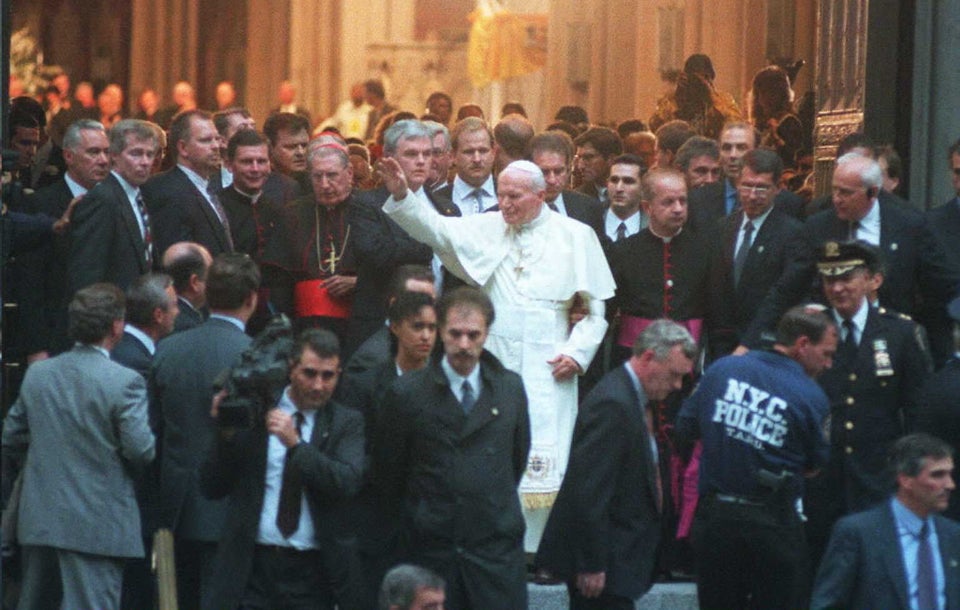
Pope John Paul II leaves St. Patrick's Cathedral on Oct. 7, 1995, in New York surrounded by security and police as he heads for an impromptu walk down Fifth Avenue.

Pope John Paul II prepares communion during an outdoor Mass in New York's Central Park, Oct., 7, 1995.
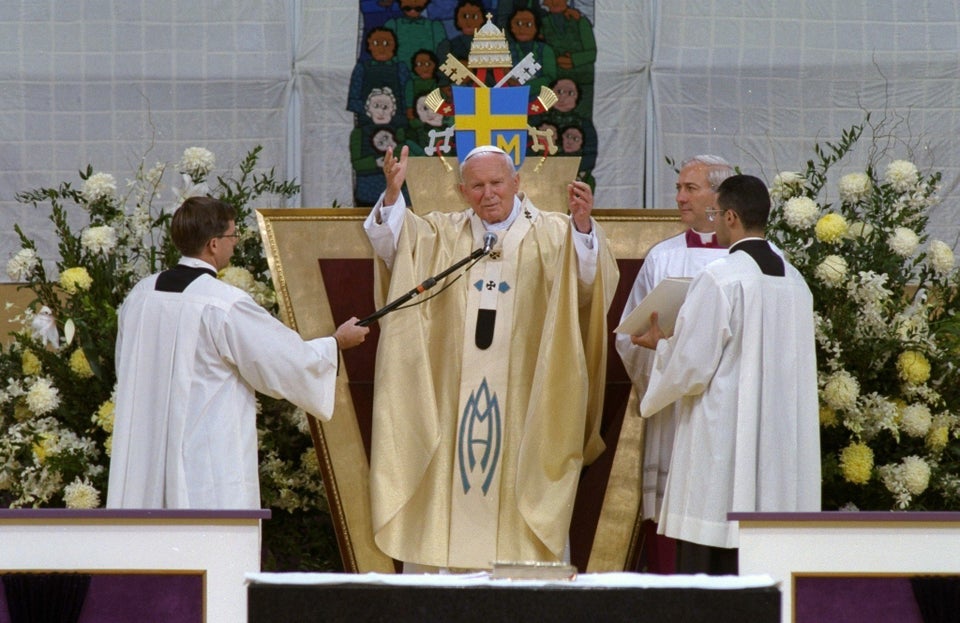
Pope John Paul II during Mass in Central Park on Oct. 8, 1995.
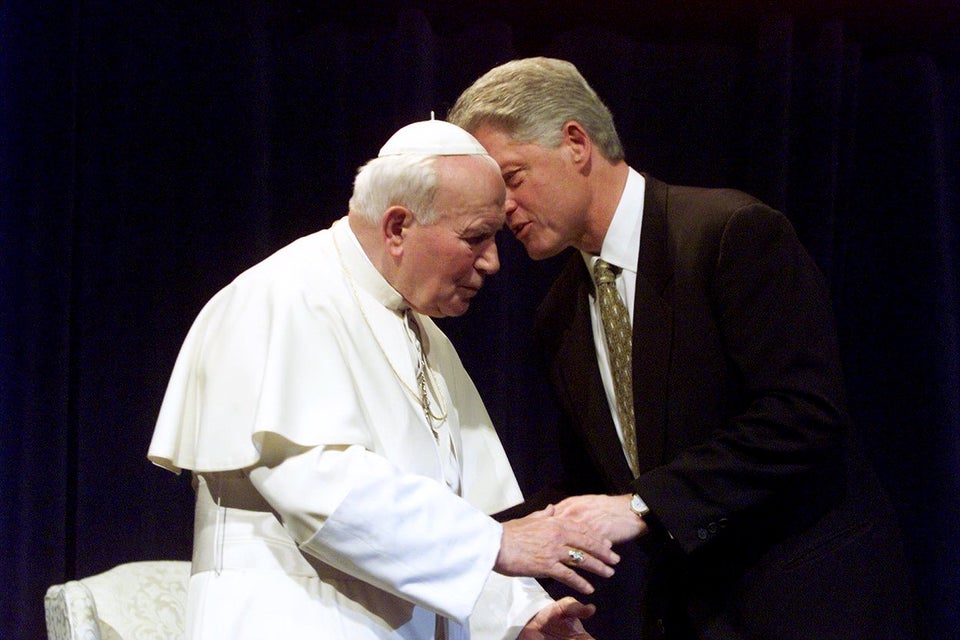
Pope John Paul II greets President Bill Clinton during his visit to St. Louis in 1999.
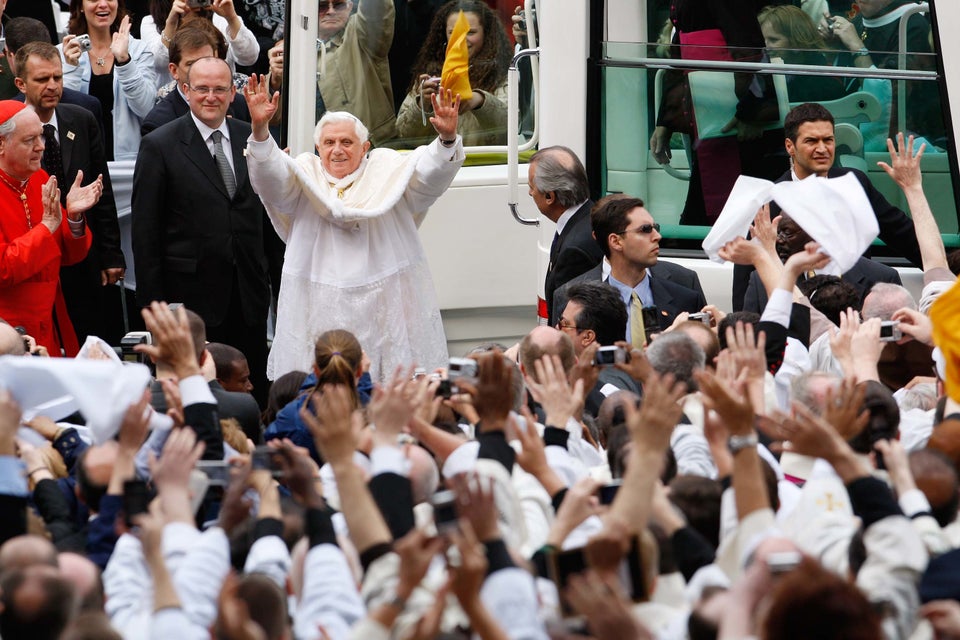
Pope Benedict XVI waves to supporters after exiting the popemobile at Yankee Stadium in the Bronx borough of New York, U.S., on Sunday, April 20, 2008.

Pope Benedict XVI gestures as he arrived for a mass at the Yankee Stadium in New York on April 20, 2008.
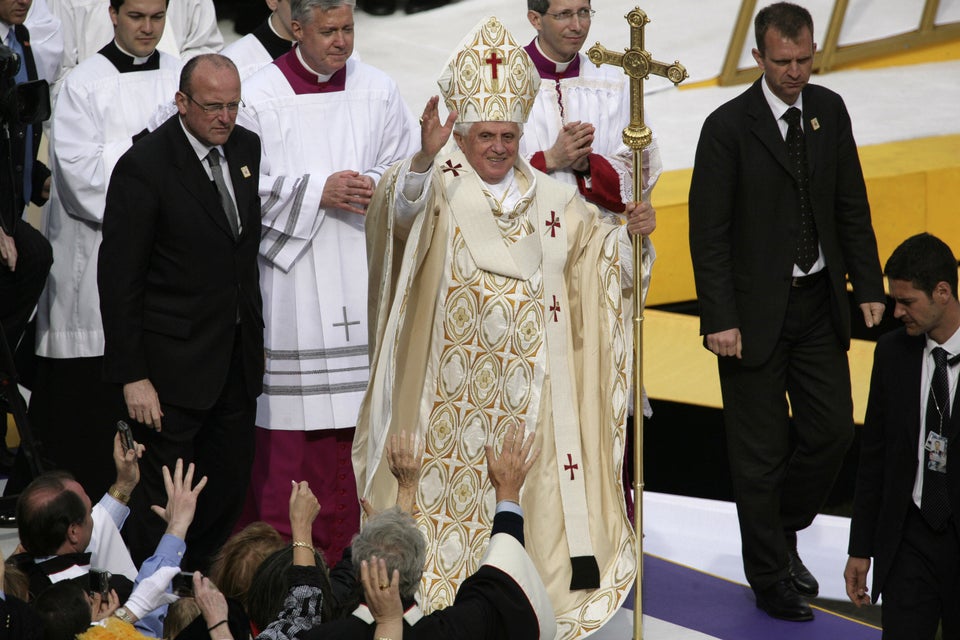
Pope Benedict XVI waves after the conclusion of Mass at Yankee Stadium in New York on April 20, 2008.
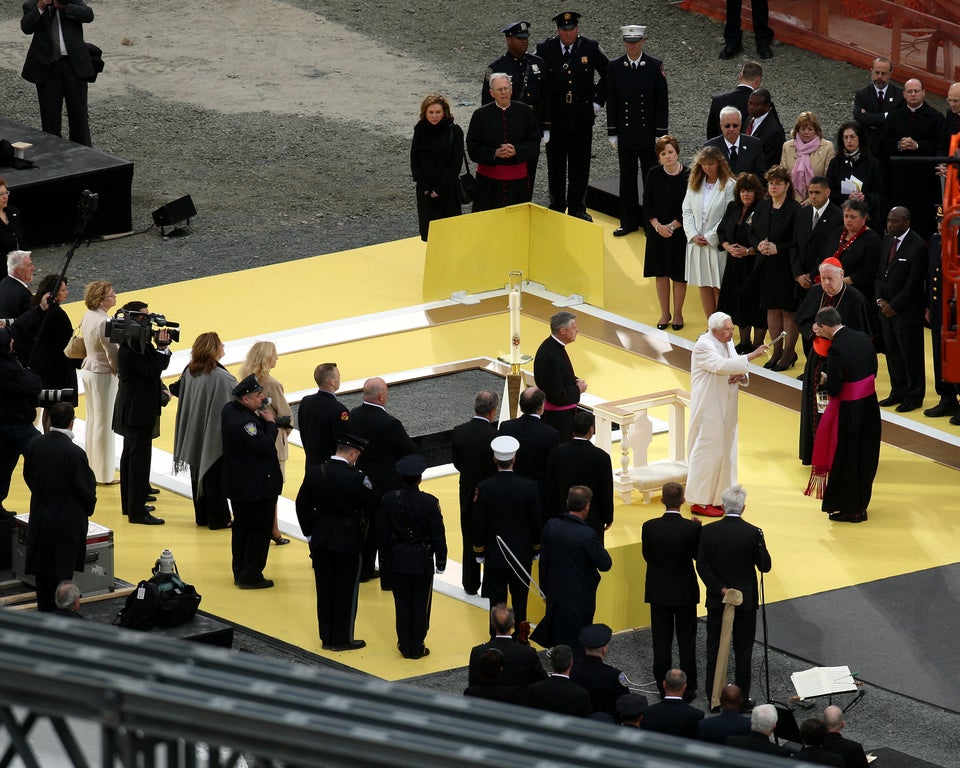
Pope Benedict XVI gives a blessing with holy water during ceremonies at Ground Zero on his last day in New York on April 20, 2008.
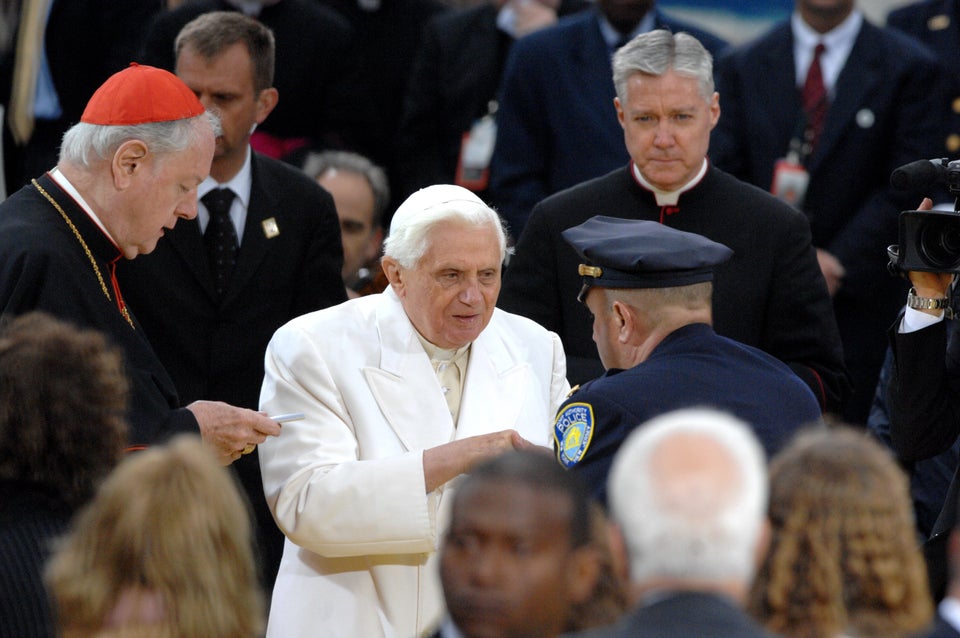
Pope Benedict XVI visits Ground Zero on his final day in New York City, April 20, 2008.
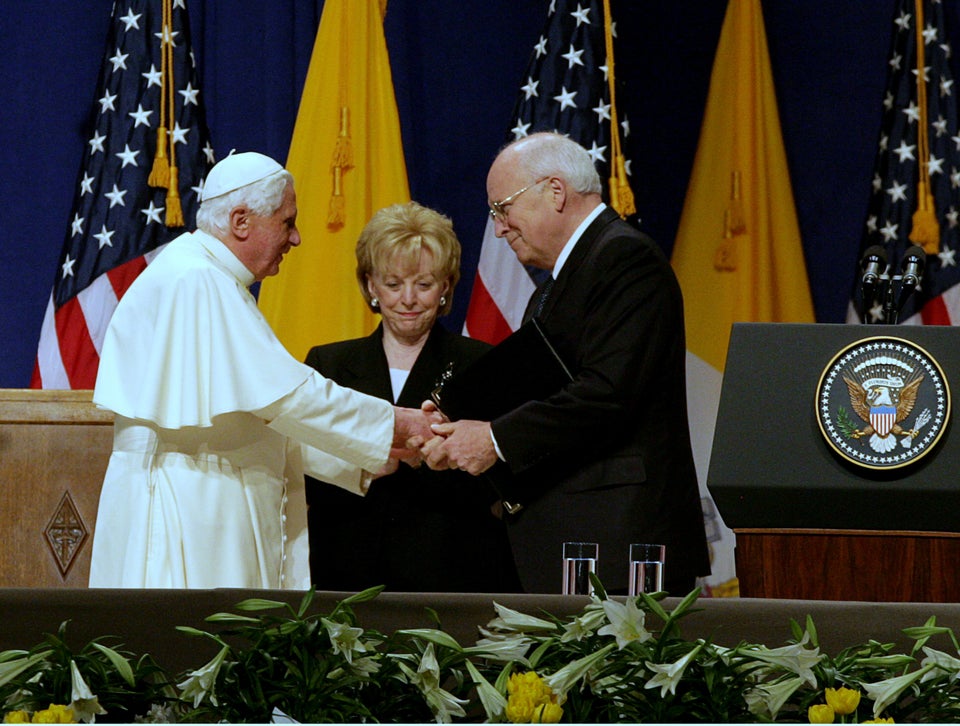
Pope Benedict XVI speaks at JFK International Airport, joined by Vice President Richard and Mrs. Lynne Cheney during his farewell ceremony on April 21, 2008.
Also on HuffPost:
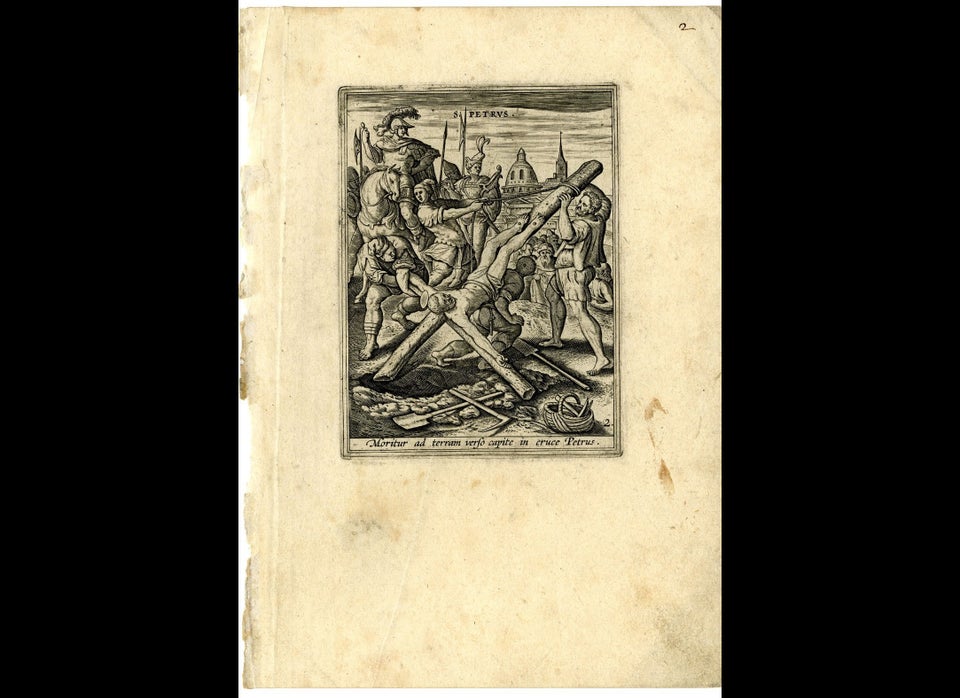
Popes Who Shook The World
Support huffpost, our 2024 coverage needs you, your loyalty means the world to us.
At HuffPost, we believe that everyone needs high-quality journalism, but we understand that not everyone can afford to pay for expensive news subscriptions. That is why we are committed to providing deeply reported, carefully fact-checked news that is freely accessible to everyone.
Whether you come to HuffPost for updates on the 2024 presidential race, hard-hitting investigations into critical issues facing our country today, or trending stories that make you laugh, we appreciate you. The truth is, news costs money to produce, and we are proud that we have never put our stories behind an expensive paywall.
Would you join us to help keep our stories free for all? Your contribution of as little as $2 will go a long way.
Can't afford to donate? Support HuffPost by creating a free account and log in while you read.
As Americans head to the polls in 2024, the very future of our country is at stake. At HuffPost, we believe that a free press is critical to creating well-informed voters. That's why our journalism is free for everyone, even though other newsrooms retreat behind expensive paywalls.
Our journalists will continue to cover the twists and turns during this historic presidential election. With your help, we'll bring you hard-hitting investigations, well-researched analysis and timely takes you can't find elsewhere. Reporting in this current political climate is a responsibility we do not take lightly, and we thank you for your support.
Contribute as little as $2 to keep our news free for all.
Dear HuffPost Reader
Thank you for your past contribution to HuffPost. We are sincerely grateful for readers like you who help us ensure that we can keep our journalism free for everyone.
The stakes are high this year, and our 2024 coverage could use continued support. Would you consider becoming a regular HuffPost contributor?
The stakes are high this year, and our 2024 coverage could use continued support. If circumstances have changed since you last contributed, we hope you’ll consider contributing to HuffPost once more.
Already contributed? Log in to hide these messages.
Popular in the Community
From our partner, more in religion.
A blog of the U.S. National Archives

Pieces of History
Papal visits to the United States
Pope Francis’s visit this September marks the 10th time a Pope has visited the United States.
Since the Federal Government is heavily involved in a papal visit, and the National Archives holds the records of the Federal Government, we have documents related to all these events.
The first Pope to visit the United States was Pope Paul VI, who met with President Lyndon Johnson at the Waldorf Astoria hotel in New York City. This was Paul VI’s only visit to the United States.

Nearly 15 years passed before another papal visit. In 1979, Pope John Paul II came to the United States and became the first Pope to visit the White House. Pope John Paul II visited the United States a total seven of times.

On April 16, 2008, on his 81st birthday, Pope Benedict XVI visited President George W. Bush at the White House. This was the most recent papal visit until this week.

Search our Online Catalog for more documents and photographs of papal and other dignitaries’ visits.
Share this:
Leave a reply cancel reply.
Your email address will not be published. Required fields are marked *
Save my name, email, and website in this browser for the next time I comment.
Papal Visits
By William Madges
Popes use their visits to encourage faith, emphasize their priorities, and fulfill their role as pastors. The places visited use these trips to highlight their successes, history, and culture on an international stage. Prior to the visit of Pope Francis (b. 1936) to Philadelphia on September 26 and 27, 2015, only one other pope had made an official visit to the city. Pope John Paul II (1920-2005) came on October 3 and 4, 1979, as part of his first trip to the United States as pope. As Cardinal Wojtyła, he had visited Philadelphia in August 1976, representing Pope Paul VI at the International Eucharistic Congress during the celebration of the nation’s bicentennial.
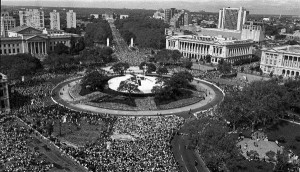
John Paul II enjoyed a close relationship with John Cardinal Krol (1910-96), archbishop of Philadelphia (1961-88), a fellow Pole with whom he shared similar views concerning theology and church discipline. The large Catholic population of the archdiocese (more than 1.3 million), the historical significance of the city, and the pope’s friendship with Cardinal Krol were all factors in Philadelphia’s selection for a visit.
Before Philadelphia, John Paul II visited the General Assembly of the United Nations in New York, where he enunciated themes repeated in Philadelphia: the dignity of the human person, fundamental human rights, and the primacy of spiritual and moral values over material and technological progress. In 1979, Philadelphia was like many other urban centers, experiencing declining influence relative to the suburbs. During the 1972-80 tenure of Mayor Frank Rizzo (1920-91), a time of white flight to the suburbs and increases in crime rates, taxes, and poverty, tensions ran high between white residents and African Americans. In this context, in the Cathedral of Saints Peter and Paul , the pope prayed that everyone in the region would “succeed in making your inner city and suburbs places where people are no strangers to each other, where every man, woman and child feels respected; where nobody feels abandoned, rejected or alone.” In his homily at the Mass in Logan Circle that followed, John Paul urged the estimated 400,000 participants to preserve the human and Christian values—especially liberty and justice—of the city’s and the nation’s heritage. Before leaving, the pope met with seminarians and priests, Hispanic Catholics, and Ukrainian Catholics.
World Meeting of Families
Philadelphia’s second opportunity for a papal visit emerged in connection with the city’s hosting of the 2015 World Meeting of Families, a triennial event established by John Paul II to encourage discussion of the challenges and contributions of family life. The two-day papal visit was planned to encompass the meeting’s concluding events, a family festival (September 26) and a Mass on the Benjamin Franklin Parkway (September 27). Organizers projected that the Mass featuring the pope would draw between one and two million people.
In addition to appealing to the local Catholic community, the prospect of a second papal visit also drew support from civic and business leaders eager to encourage business opportunities and tourism by presenting Philadelphia as a city of global stature. A delegation including Robert J. Ciaruffoli (b. 1951), a top executive at accounting firm Baker Tilly, and Daniel Hilferty (b. 1957), Independence Blue Cross CEO, joined Mayor Michael Nutter (b. 1957), Governor Tom Corbett (b. 1949), and Archbishop Charles Chaput (b. 1944) in flying to Rome in March 2014 to encourage the pope to come to Philadelphia. The religiously diverse Executive Leadership Cabinet of the World Meeting of Families also reflected broad support.
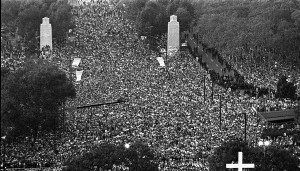
The pope’s vigorous engagement with contemporary issues added to public interest in the visit, as evinced by newspaper articles, op-eds, and letters on the subject. Since his election in March 2013, the pope called for serving the urgent needs of migrants and refugees, protecting the environment, and making economic systems more just. He also sought to persuade the Church to be more concerned with compassionate service to all, especially the marginalized, rather than with a rigid adherence to doctrinal orthodoxy. His message resonated not only with Catholics, but also with many others. At the same time, the pope’s insistence that humans had a moral obligation to become good stewards of the earth, instead of degrading the environment and inflicting suffering on the poor across the globe, led some conservatives to argue that the pope should steer clear of forays into “scientific” matters.
The Pope’s Itinerary
Like John Paul II before him, Francis’ arrival in Philadelphia followed an address at the United Nations in New York. Echoing themes from that address, in Philadelphia Francis—using the same lectern that Abraham Lincoln used to deliver the Gettysburg Address—spoke about religious freedom and immigration at Independence Hall on September 26. He also met with selected prisoners and their families at the Curran-Fromhold Correctional Facility before celebrating a concluding Mass on the Benjamin Franklin Parkway on September 27.
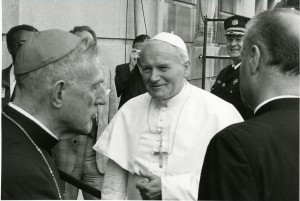
While the two papal visits have many similarities, fund-raising for the 2015 visit of Pope Francis differed from its 1979 precedent. In 1979, after Mayor Frank Rizzo announced that the city would cover the $205,569 expense of the platform and decorations for the public Mass, the ACLU filed and won a lawsuit against Philadelphia for violating the First Amendment. In 2015, no public funds were to be used to cover the estimated $45 million cost of infrastructure, security, and cleanup for the World Meeting of Families and the papal visit. A development committee chaired by Eustace Mita , CEO of Achristavest, a waterfront development company, led the fund-raising. In addition to appealing to local businesses, foundations, and individual philanthropists for most of the needed funds, the committee created opportunities for supporters to purchase merchandise online, to donate $10 to light a candle for one’s intentions at the Cathedral Basilica, and to designate the World Meeting of Families as a preferred charity to receive a percentage of purchases made on Amazon.com.
Security measures in 2015 were also far more robust than in 1979, which preceded the era of the 9/11 attacks and the rise of al Qaeda and ISIS. The first papal visit had no secure vehicle perimeter to block traffic, nor was there screening of visitors with magnetometers or high fences severely restricting access to the principal papal venues. The 2015 visit, designated a National Special Security Event by the U.S. secretary of Homeland Security , led the city to implement unprecedented travel restrictions, criticized by some as excessive. These measures included closing the Benjamin Franklin Bridge , the Vine Street Expressway, and large stretches of the Schuylkill Expressway to private vehicles and preventing incoming traffic into the three-square-mile papal security perimeter for the entire weekend.
About one month before the pope’s visit, city officials and World Meeting of Families supporters mounted a campaign to undo negative publicity brought by uncertainties over security and transportation issues, including distribution of “OpeninPHL” kits to downtown businesses and assurances that the city would take the event in stride.
Despite the inconvenience caused by the travel restrictions and disruption created by the huge influx of visitors, Philadelphia expected to net more than $400 million in economic benefit from the 2015 papal visit. Hotels and restaurants expected to reap the greatest profit, but local merchants—especially the official retail vendor, Aramark— also stood to benefit from the selling of papal paraphernalia, including the papal bobblehead doll with cheesesteak in hand, T-shirts, coffee mugs, and religious articles. In the final months prior to the pope’s arrival, local media intensified their coverage of the preparations for the papal visit, providing daily updates as their papal clocks counted down to Francis’s visit, expected to be the largest event thus far in Philadelphia history.
William Madges , Ph.D., is a professor of theology in the Department of Theology and Religious Studies at Saint Joseph’s University. His most recent publication is a translation of Walter Kasper’s Pope Francis’ Revolution of Tenderness and Love (New York: Paulist Press, 2015).
Copyright 2015, Rutgers University
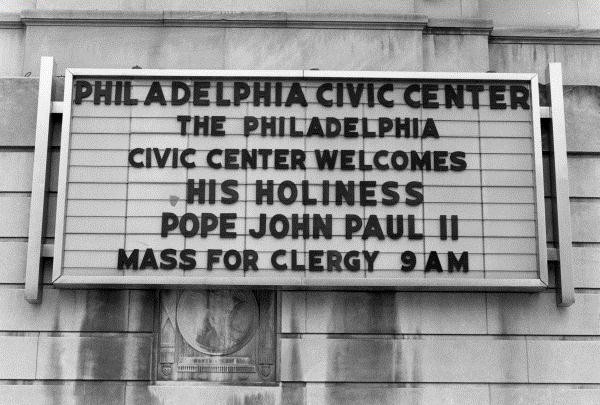
Philadelphia Civic Center Clergy-Only Mass
PhillyHistory.org
This sign at the old Civic Center in 1979 heralded Pope John Paul II's visit to Philadelphia, during which he held two Masses, one in Logan Circle for the public and the other at the Philadelphia Civic Center for 10,000 priests and 3,000 nuns.
During Pope Francis's 2015 visit to Philadelphia, two Masses were scheduled, the first at 10:30 a.m. September 26 at the Cathedral Basilica of Saints Peter and Paul for local religious and those with personal invitations.
The second, open to the public, occurred on September 27, when the pope celebrated the closing mass for the World Meeting of Families. He officiated from a stage in Eakins Oval in front of the Philadelphia Museum of Art.
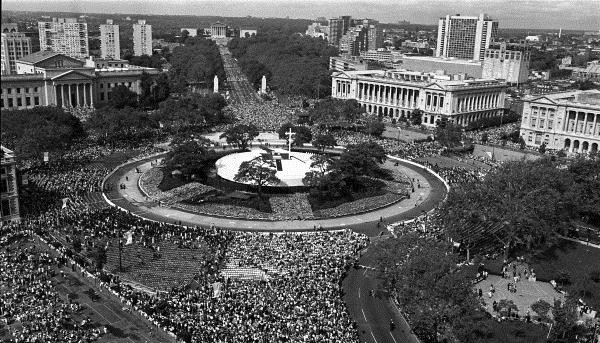
Logan Circle Stage for Pope John Paul II, 1979
The public Mass held in Logan Circle on October 3, 1979, drew more than a million people, according to police estimates at the time, stretching on the Benjamin Franklin Parkway from City Hall to the Art Museum.
Although the one million attendance figure has been widely used since Pope John Paul II's 1979 visit, and organizers at the World Meeting of Families 2015 predicted more than one million people would attend a parkway Mass on September 27, recent appraisals by crowd specialists say that the parkway can hold only about 400,000 people. Organizers set up giant screens beyond the parkway to handle the overflow.
In 1979, the papal stage and altar at Logan Circle brought controversy as Mayor Frank Rizzo spent $205,569 of public funds during its construction. A lawsuit filed by the American Civil Liberties Union against the City of Philadelphia argued that using public money to build the stage amounted to “public sponsorship of a religious service.” The city lost the lawsuit and the Archdiocese of Philadelphia reimbursed the costs of the construction.
To avoid a similar issue with the 2015 visit of Pope Francis, the City of Philadelphia made clear that the $45 million in expenses for the papal event would be paid by the World Meeting of Families, covering all religious and nonreligious aspects of the visit.
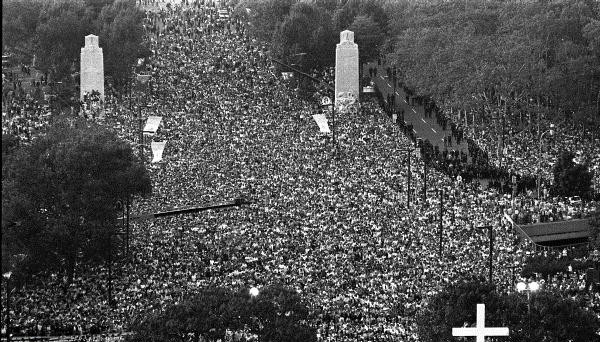
Crowd at Pope John Paul II's Mass in 1979
During the 1972 to 1980 tenure of Mayor Frank Rizzo, a time of white flight to the suburbs and increases in crime rates, taxes, and poverty, tensions ran high between white residents and African Americans. In this context, in the Cathedral of Saints Peter and Paul, the pope prayed that everyone in the region would “succeed in making your inner city and suburbs places where people are no strangers to each other, where every man, woman and child feels respected; where nobody feels abandoned, rejected or alone.” In his homily at the Mass in Logan Circle that followed, John Paul urged the hundreds of thousands in attendance to preserve the human and Christian values—especially liberty and justice—of the city’s and the nation’s heritage.
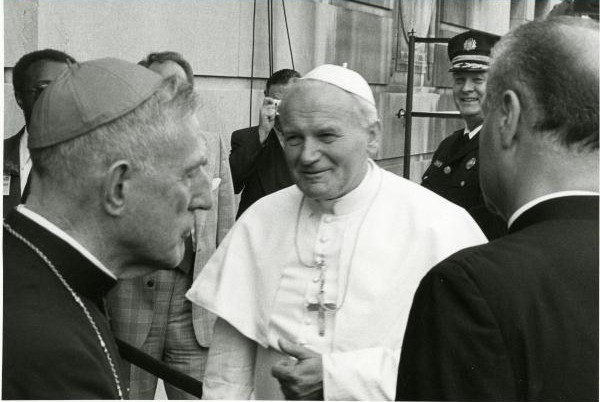
Pope John Paul II
Pope John Paul II (1920-2005), shown here, was the only other pope to make an official visit to Philadelphia, on October 3 and 4, 1979, as part of his first trip to the United States as pope. Popes use their visits to encourage faith, emphasize their priorities, and fulfill their role as pastors. The places visited use these trips to highlight their successes, history, and culture on an international stage.
Traffic Perimeter for Pope's Visit
Security measures in 2015 were far more robust than in 1979. The first papal visit had no secure vehicle perimeter to block traffic, nor was there screening of visitors with magnetometers or high fences severely restricting access to the principal papal venues. The 2015 visit, designated a National Special Security Event by the U.S. secretary of Homeland Security, led authorities to implement unprecedented travel restrictions, criticized by some as excessive. These measures included closing the Benjamin Franklin Bridge, the Vine Street Expressway, and large stretches of the Schuylkill Expressway to private vehicles and preventing incoming traffic into the three-square-mile papal security perimeter, shown here, for the entire weekend.
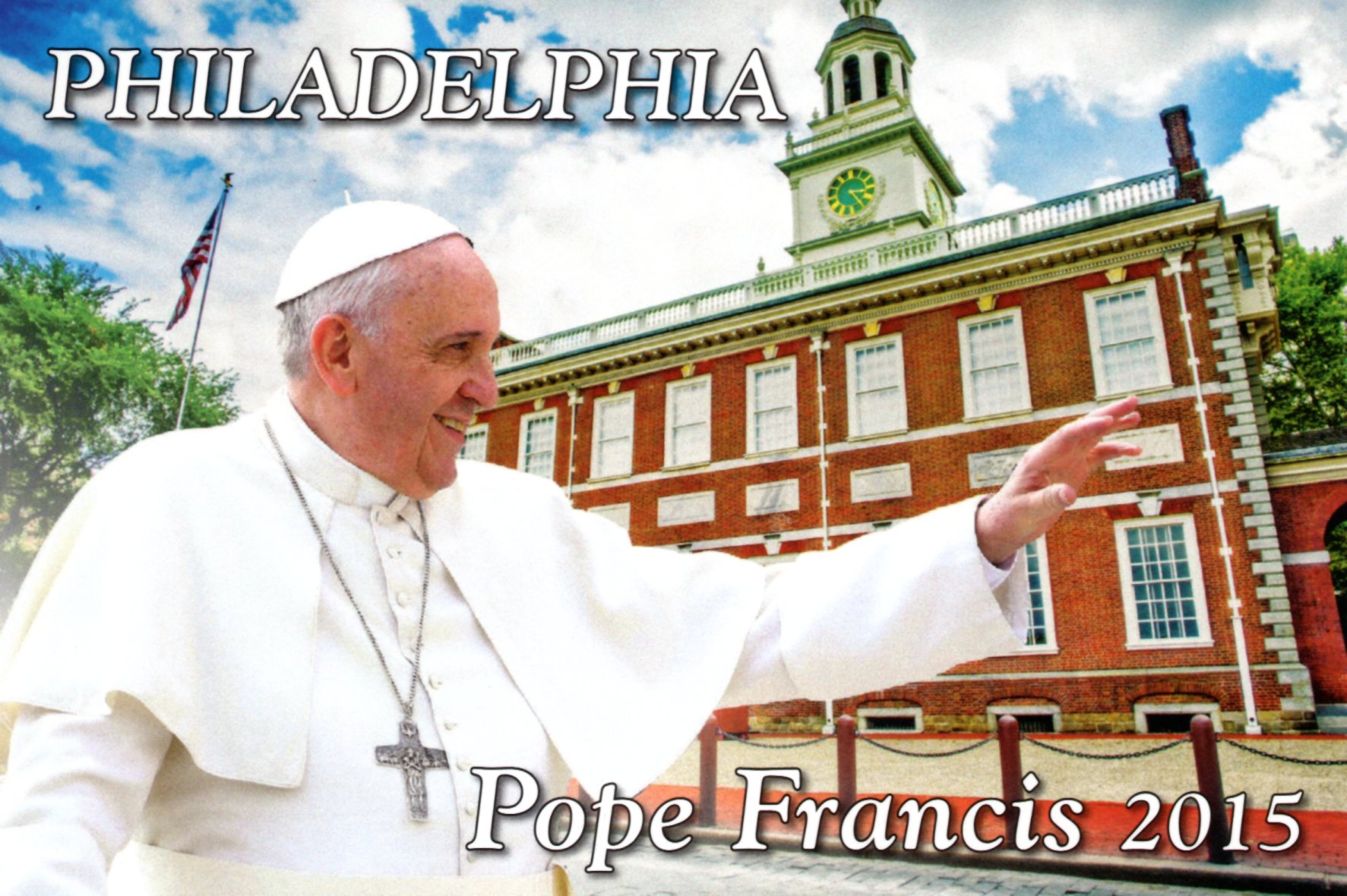
Historic Visit
This postcard peddled by a vendor on Market Street, anticipated the arrival of Pope Francis at Independence Hall, where he spoke about immigration and religious freedom.
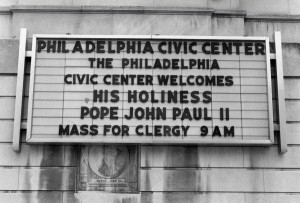
Related Topics
- Holy Experiment
- Philadelphia and the World
- Philadelphia and the Nation
- Philadelphia, the Place that Loves You Back
- City of Brotherly Love
Time Periods
- Twenty-First Century
- Twentieth Century after 1945
- Center City Philadelphia
- Cathedral Basilica of Saints Peter and Paul
- Roman Catholic Parishes
- Benjamin Franklin Parkway
- Missionaries
Related Reading
Ivereigh, Austen. The Great Reformer: Francis and the Making of a Radical Pope . New York: Henry Holt, 2014.
Pilgrim of Peace: The Homilies and Addresses of His Holiness Pope John Paul II on the Occasion of His Visit to the United States of America . Washington, D.C.: United States Catholic Conference, 1979.
Simon, Roger D. Philadelphia: A Brief History . Harrisburg, Pa.: Huggins Printing Co., 2003.
Walsh, Mary Ann, ed. John Paul II: A Light for the World . New York: Sheed & Ward, 2003.
Weigel, George. A Witness to Hope: The Biography of Pope John Paul II . New York: HarperCollins, 2005.
Weigley, Russell F, ed. Philadelphia: A 300-Year History . New York: W.W. Norton, 1982.
Related Collections
Papal Visit-John Paul II 1979 Collection, Philadelphia Archdiocesan Historical Research Center , 100 E. Wynnewood Road, Wynnewood, Pa.
Related Places
Cathedral Basilica of Saints Peter and Paul , Eighteenth Street and Benjamin Franklin Parkway, Philadelphia.
Independence Hall , Chestnut Street between Fifth and Sixth Streets, Philadelphia.
St. Charles Borromeo Seminary , 100 Wynnewood Rd., Wynnewood, Pa.
Temporary exhibits related to 2015 visit of Pope Francis ( listed by Philly.com ).
Backgrounders
Connecting Headlines with History
- Pope In Philly: FAQ (WHYY, July 13, 2015)
- PATCO readies rail passes for pope's visit (WHYY, July 16, 2015)
- Welcome Pope banner unveiled at cathedral (WHYY, July 29, 2015)
- Prison workshop crafting chair for Pope Francis (WHYY, August 24, 2015)
- Bike enthusiast plans a "pope ride" (WHYY, August 26, 2015)
- Papal tickets revive interest in visit for some suburban parishes (WHYY, September 7, 2015)
- SEPTA offering more subway stops for pope weekend and credits to monthly pass holders (WHYY, September 8, 2015)
- Philly side hustle will be on full display during papal visit (WHYY, September 17, 2015)
- Five things Philly officials learned from Pope Francis' visit (WHYY, November 11, 2015)
- Philadelphia to absorb $8 million in papal costs (WHYY, December 3, 2015)
- Security, vending plans for DNC convention differ from papal preparations (WHYY, March 28, 2016)
- New housing facility in the name of Pope Francis opens in Philadelphia (WHYY, May 4, 2016)
- Philly Orchestra sues for unpaid $70K bill from papal performances (WHYY, October 27, 2016)
- Extravaganzas and inconveniences: Philly becoming host with the most (WHYY, May 1, 2017)
- Schedule: 2015 Apostolic Journey of Pope Francis to the United States of America
- For Teachers: The Vatican and Social Change: The Pope Visits Philadelphia (Historical Society of Pennsylvania)
- World Meeting of Families 2015
- Papal Visit Playbook (World Meeting of Families)
- A Hope For The Pope Under The Gold Dome (Hidden City Philadelphia)
- The Pope 2015 Visit to Philadelphia (Collection from Philadelphia Inquirer, Daily News, Philly.com)
- The Holy See
- Archdiocese of Philadelphia
- Catholic News Service
- Ticketed Areas for Pope's Visit (Philly.com, September 3, 2015)
- Papal parade plans released after public outcry over required tickets (Philly.com, September 4, 2015)
- Address of the Holy Father at Independence Hall (The Holy See)
Connecting the Past with the Present, Building Community, Creating a Legacy
The First Time a Pope Visited the U.S. Was Much More Complicated
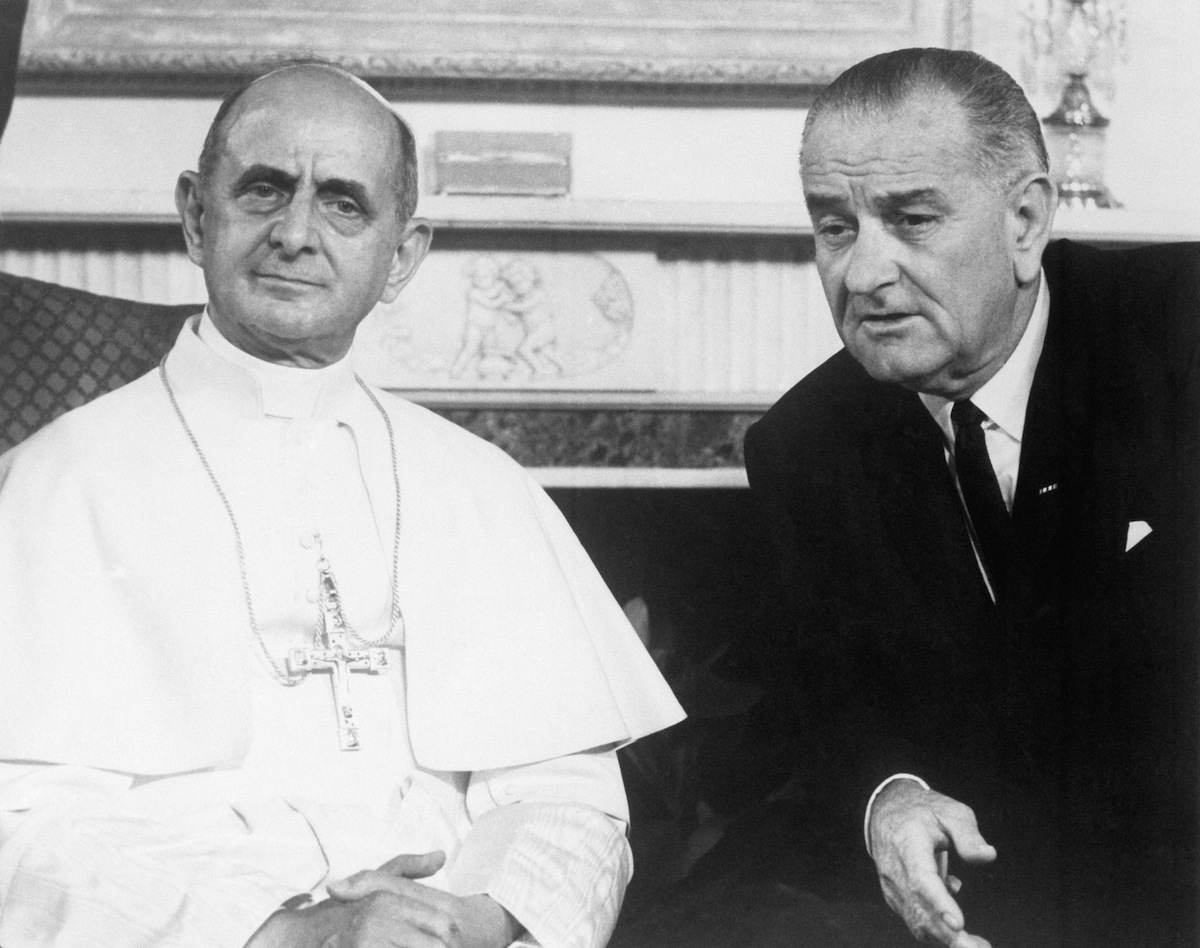
A s the the world will see clearly this week, the United States knows how to make a big deal out of a papal visit. When Pope Francis arrives in Washington, D.C. Tuesday, it will begin days of fanfare everywhere from the White House to the United Nations.
Things were far more complicated when the first-ever papal visit to the U.S. took place almost exactly 50 years ago.
In 1965, Pope Paul VI planned a trip to New York in order to address the then-relatively-new United Nations and urge peace, especially as conflict between India and Pakistan was heating up.
The challenge for U.S. officials was that the nation didn’t have formal diplomatic relations with the Vatican. Many Americans believed that to do so would violate the separation of church and state and could give the Holy See undue influence. (Washington changed its mind in the early ’80s.) That lack for recognition meant that President Lyndon Johnson couldn’t treat Pope Paul VI like a visiting head of state. But nor could he ignore him. Snubbing the pope on his first ever visit to the U.S. would have been taken as an insult by Catholics the world over.
The solution? A clever bit of timing–or political ruse, depending on one’s perspective.
The White House said Johnson was already planning in New York for meetings. Given that, it would stand to reason that the two would find some to talk. Sure enough, the pope and the president met at the Waldorf-Astoria hotel to discuss how to make the world a more peaceful place. Other highlights of the papal visit included paying calls at St. Patrick’s Cathedral (where Pope Francis will attend Vespers on Thursday) and leading a Mass at Yankee Stadium (Pope Francis’ equivalent will be at Madison Square Garden).
And those aren’t the only ties between Pope Francis’ modern visit and Pope Paul’s inaugural trip: the dates for Paul VI’s visit to the United States were chosen, as TIME reported back then, to coincide with the feast of Saint Francis of Assisi, on the idea that he was the namesake of San Francisco, which was where the United Nations was born. Of course, Saint Francis also inspired a certain someone who’ll be speaking at the U.N. in New York on Friday.
See Photos of Every Papal Visit to the U.S. in History
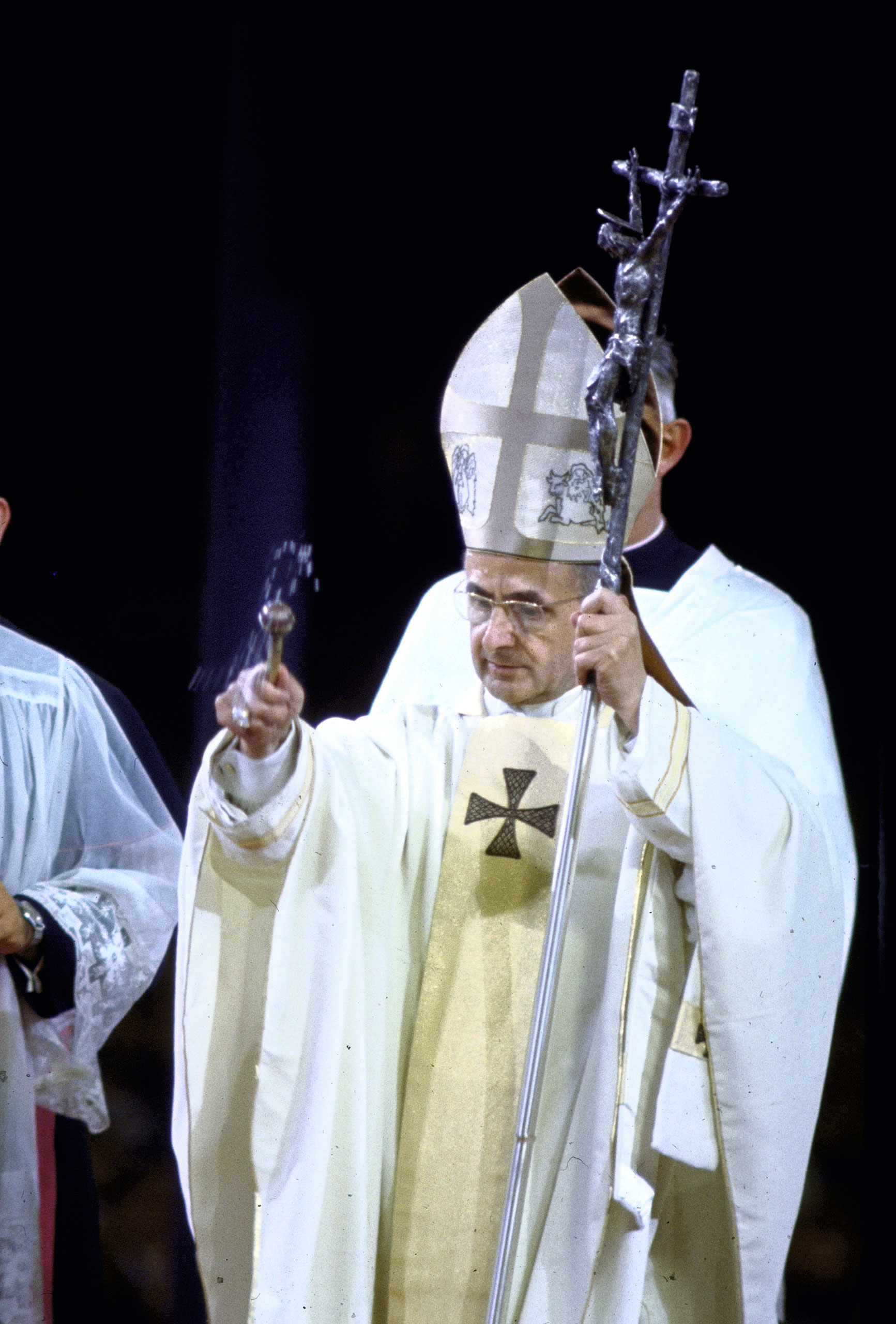
More Must-Reads From TIME
- The 100 Most Influential People of 2024
- The Revolution of Yulia Navalnaya
- 6 Compliments That Land Every Time
- What's the Deal With the Bitcoin Halving?
- If You're Dating Right Now , You're Brave: Column
- The AI That Could Heal a Divided Internet
- Fallout Is a Brilliant Model for the Future of Video Game Adaptations
- Want Weekly Recs on What to Watch, Read, and More? Sign Up for Worth Your Time
Write to Lily Rothman at [email protected]
- Asia - Pacific
- Middle East - Africa
- Apologetics
- Benedict XVI
- Catholic Links
- Church Fathers
- Life & Family
- Liturgical Calendar
- Pope Francis
- CNA Newsletter
- Editors Service About Us Advertise Privacy

Remembering Pope Benedict XVI’s visit to the United States
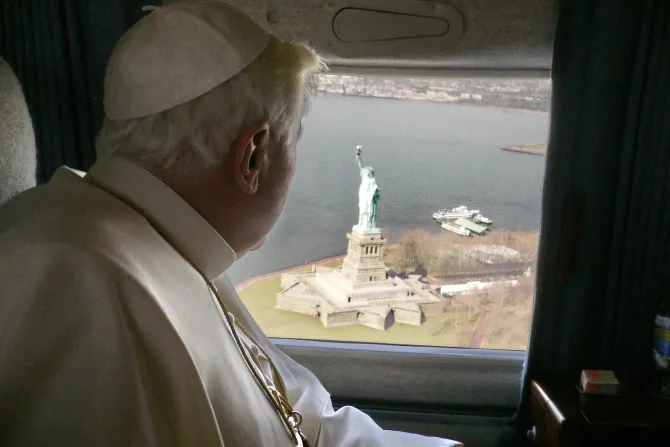
By Jonah McKeown
St. Louis, Mo., Jan 2, 2023 / 10:00 am
Pope Benedict XVI, who died Saturday, visited the United States only once, but he left a lasting impression.
The spring 2008 trip included a Mass celebrated at the then brand-new Washington Nationals baseball stadium, a solemn prayer service at Lower Manhattan’s Ground Zero, and an address to the United Nations.
Amid some commentators’ worries that the pope would use the visit to “scold” America, Benedict did not mince words during his trip, but nevertheless he endeared himself to the American public. A May 2008 survey from the Pew Research Center found that more Americans had a “favorable opinion” of the pope following his visit than they had before.
Benedict arrived in the U.S. on April 15, 2008, landing at Andrews Air Force Base near Washington, D.C. President George W. Bush greeted the pontiff on the tarmac — a notable detail, since presidents generally waited for foreign dignitaries to arrive at the White House.
Bush said in an interview with EWTN ahead of the meeting that he agreed with the pope’s observations about moral relativism, saying that it “undermines the capacity to have hopeful and free societies.”
The next day, which happened to be Benedict’s 81st birthday, the president welcomed the pope to the White House. In his opening remarks, Bush highlighted the religious roots of the United States and the values of defending life and religious freedom, telling the pope that the U.S. needs his encouragement in fostering these values.
The pope responded by expressing his pleasure to be present in the United States as a guest, indicated his “great respect for this pluralistic society,” and expressed hope that he would be able to meet with religious leaders of a wide range of traditions.
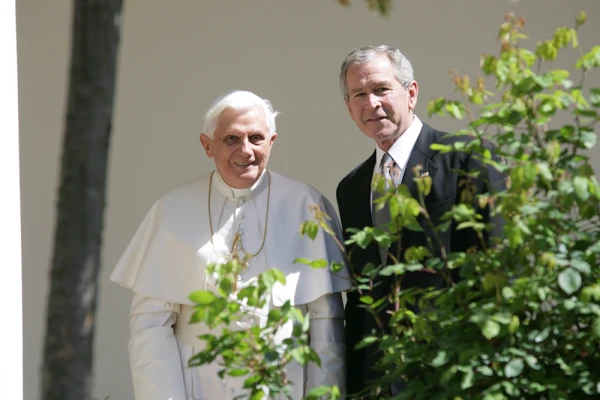
The ongoing sexual abuse crisis, spurred by numerous revelations of abuse in the U.S. in 2002, loomed large over the pope’s visit, and Benedict did not shy away from discussing it openly. Addressing the bishops of the United States later that day, April 16, the pope said the sexual abuse scandal had been “very badly handled” and said they must reach out with love and compassion to victims.
He later met with a half-dozen sexual abuse victims in the chapel of the papal embassy, telling the survivors he would pray for them, their families, and all victims of clergy sex abuse.
He also addressed the topic during his homily at Mass at Nationals Park in Washington, D.C., on April 17, which attracted some 46,000 attendees.
“I acknowledge the pain which the Church in America has experienced as a result of the sexual abuse of minors,” Benedict said during the homily.
“No words of mine could describe the pain and harm inflicted by such abuse. It is important that those who have suffered be given loving pastoral attention. Nor can I adequately describe the damage that has occurred within the community of the Church. Great efforts have already been made to deal honestly and fairly with this tragic situation and to ensure that children — whom our Lord loves so deeply, and who are our greatest treasure — can grow up in a safe environment. These efforts to protect children must continue. … Today I encourage each of you to do what you can to foster healing and reconciliation, and to assist those who have been hurt.”
Explaining his purpose of his trip, he said: “I have come to repeat the Apostle’s urgent call to conversion and the forgiveness of sins, and to implore from the Lord a new outpouring of the Holy Spirit upon the Church in this country.”
In closing, the pope returned to his call for a renewal of the Church in America, saying that it “depends on the renewal of the practice of Penance and the growth in holiness which that sacrament both inspires and accomplishes.”
Later that day, Benedict addressed the heads of more than 200 U.S. Catholic colleges and universities and 195 Catholic dioceses’ superintendents at The Catholic University of America on the topic of Catholic identity in education.
The pope told the educators: “A university or school’s Catholic identity is not simply a question of the number of Catholic students. It is a question of conviction — do we really believe that only in the mystery of the Word made flesh does the mystery of man truly become clear? Are we ready to commit our entire self — intellect and will, mind and heart — to God? Do we accept the truth Christ reveals? Is the faith tangible in our universities and schools? Is it given fervent expression liturgically, sacramentally, through prayer, acts of charity, a concern for justice, and respect for God’s creation?”
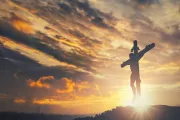
Divine Mercy novena begins on Good Friday
“Only in this way do we really bear witness to the meaning of who we are and what we uphold,” he said.
He also met with representatives of other religions, including Jewish leaders.
The pope said in his address: “The task of upholding religious freedom is never completed. New situations and challenges invite citizens and leaders to reflect on how their decisions respect this basic human right. Protecting religious freedom within the rule of law does not guarantee that peoples — particularly minorities — will be spared from unjust forms of discrimination and prejudice. This requires constant effort on the part of all members of society to ensure that citizens are afforded the opportunity to worship peaceably and to pass on their religious heritage to their children.”
Benedict then left the U.S. capital and headed to the country’s largest metropolis, New York City. After a warm welcome at John F. Kennedy International Airport, the pope headed to Manhattan to address the United Nations.
That year, 2008, marked the 60th anniversary of the Universal Declaration of Human Rights, and the pope said in his speech that human rights are inherent to human persons and not the fruit of an “agreement.” These rights, therefore, cannot be manipulated by ideological and pressure groups.
On April 20, the last day of his visit, Benedict visited Ground Zero, the memorial site of the World Trade Center towers. Sixteen family members, four first responders, and four survivors were present — and later met with the pope — as the Holy Father descended the ramp down into the pit where the Twin Towers once stood, knelt, and silently prayed.
After lighting a candle, the Holy Father offered a prayer for the victims, their families, and those who survived all three attacks on 9/11. He then blessed Ground Zero and the people present with holy water.
(Story continues below)
Subscribe to our daily newsletter
Later that day, some 60,000 people attended Mass with the pope at Yankee Stadium in New York. The pope said in his homily that true freedom is found in self-surrender and turning away from sin. The Mass also served to celebrate the 200th anniversary of the creation of the Dioceses of New York, Boston, Philadelphia, and Louisville from the mother Diocese of Baltimore, which itself was elevated to an archdiocese in 1808.

The pope then departed the United States, again from Kennedy International Airport. It remains his only visit to the United States; the next pope to visit the U.S. would be Pope Francis in 2015.
- Catholic News ,
- Pope Emeritus Benedict XVI ,
- Vatican news

Our mission is the truth. Join us!
Your monthly donation will help our team continue reporting the truth, with fairness, integrity, and fidelity to Jesus Christ and his Church.
Numbers, Facts and Trends Shaping Your World
Read our research on:
Full Topic List
Regions & Countries
- Publications
- Our Methods
- Short Reads
- Tools & Resources
Read Our Research On:
Majority of U.S. Catholics Express Favorable View of Pope Francis
But his ratings have dipped since 2021 and become politically polarized over the past decade, table of contents.
- Catholics’ views of Pope Francis
- Perceptions of Pope Francis as a source of change
- Views about the priesthood, contraception, sexuality
- Acknowledgments
- The American Trends Panel survey methodology
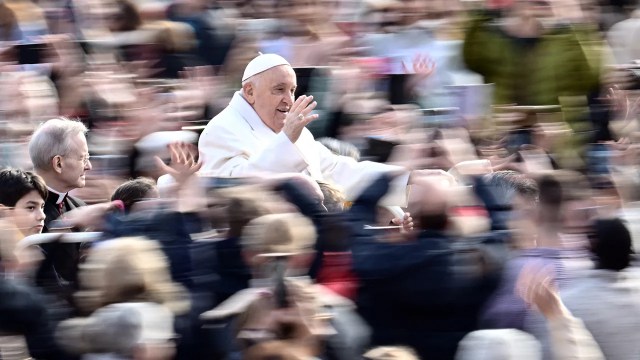
Pew Research Center conducted this survey to explore views on the Catholic Church and Pope Francis.
For this report, we surveyed 12,693 respondents from Feb. 13 to 25, 2024, including 2,019 Catholics. Most of the survey’s respondents (10,642) – including all of the survey’s Catholic respondents – are members of the American Trends Panel, an online survey panel recruited through national random sampling of residential addresses, which gives nearly all U.S. adults a chance of selection. The remaining respondents (2,051) are members of three other panels: the Ipsos KnowledgePanel, the NORC Amerispeak Panel and the SSRS Opinion Panel. All three are national survey panels recruited through random sampling (not “opt-in” polls). We used these additional panels to ensure that the survey would have enough Jewish and Muslim respondents to be able to report on their views. Jewish and Muslim respondents are not discussed in this particular report that focuses on Catholic topics, but they are discussed in other reports based on this survey .
The survey is weighted to be representative of the U.S. adult population by gender, race, ethnicity, partisan affiliation, education, religious affiliation and other categories.
For more, refer to the ATP’s Methodology and the Methodology for this report . Read the questions used in this report .
A new Pew Research Center survey finds that 75% of U.S. Catholics view Pope Francis favorably, down 8 percentage points since we last asked this question in 2021 and 15 points below his peak favorability rating, which was 90% in early 2015.
Since becoming pope in 2013, Francis often has received favorable ratings from 80% or more of U.S. Catholics. He generally has been viewed more positively than his immediate predecessor, Pope Benedict XVI, but less positively than Benedict’s predecessor, Pope John Paul II.
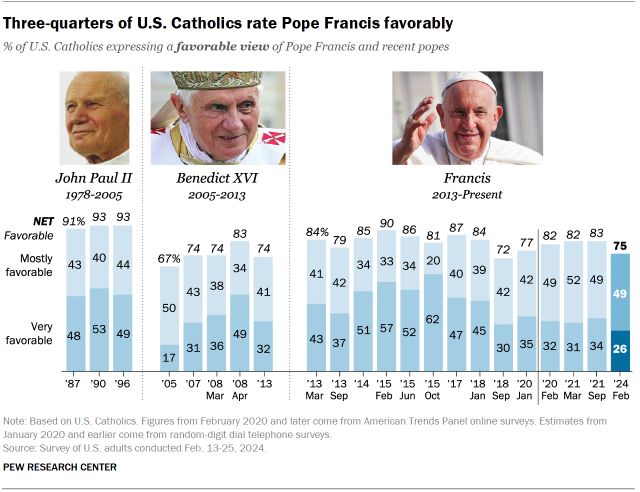
(Benedict’s favorability ratings varied between 67% and 83% during his pontificate. Upward of 90% of U.S. Catholics expressed favorable views of John Paul II on the three occasions that the Center asked about him in polls between 1987 and 1996.)
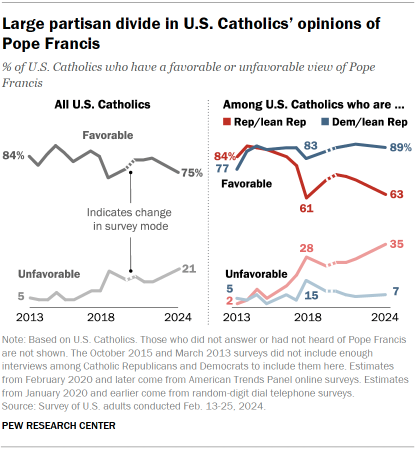
The partisan gap in views of Pope Francis is now as large as it’s ever been in our surveys. Roughly nine-in-ten Catholics who are Democrats or lean toward the Democratic Party hold a positive view of him, compared with 63% of Catholics who are Republicans or lean Republican.
Regardless of their partisan leanings, most U.S. Catholics regard Francis as an agent of change. Overall, about seven-in-ten say the current pope represents a change in direction for the church, including 42% who say he represents a major change.

Many U.S. Catholics would welcome more change. For example, the survey finds that:
- 83% of U.S. Catholics want the church to allow the use of contraception.
- 75% say the church should allow Catholics to take Communion even if they are unmarried and living with a romantic partner.
- 69% say priests should be allowed to get married.
- 64% say women should be allowed to become priests.
- 54% say the church should recognize the marriages of gay and lesbian couples.
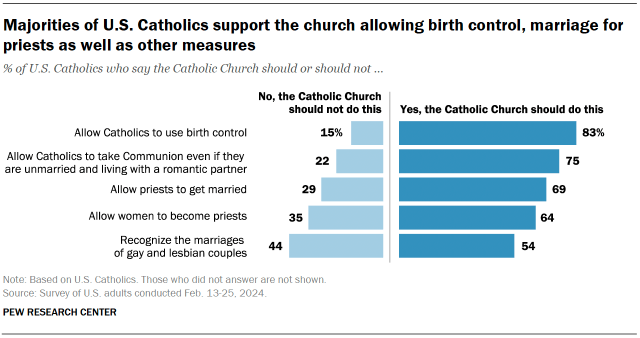
But there are also many Catholics who say the church should not take these steps. A new analysis in this report compares U.S. Catholics who favor these changes with those who oppose them. It shows that:
- The Catholics who mostly favor a variety of changes are largely Democrats or lean Democratic (57%), and many say they seldom or never attend Mass (56%).
- The Catholics who mostly say the church should not take these steps are predominantly Republicans or lean Republican (72%), and many say they attend Mass at least once a week (59%).
We used simple, common phrases in the survey questions about some steps that Catholics would – or would not – like to see the church take. Our goal was to make the questions easy to understand for as many respondents as possible. In some cases, the wording of the questions involved a trade-off between broad understandability and theological nuance.
For example, one question asks whether the church should “allow priests to get married.” This would not, strictly speaking, be a change in doctrine. The Catholic Church already allows married priests under certain circumstances , such as if a man was married before being ordained in an Eastern Catholic Church . Technically, the church considers the rule of celibacy for priests to be a “discipline” rather than a doctrine . Nonetheless, allowing parish priests to get married and continue in their duties would represent a big change in the everyday life of the church in the United States.
Similarly, another question asks whether the church should allow unmarried Catholics who “are living with a romantic partner” to receive Communion. Actually, Catholicism has no rule against unmarried people living together. The church’s teaching is that sexual activity outside of marriage is a grave sin , and that anyone “conscious of a grave sin” should not take Communion unless they have been to confession.
Yet another example concerns contraception. The survey asks whether the church should allow Catholics to “use birth control.” But the church does not object to married couples using natural methods (i.e., abstaining from sex during fertile periods) to “space the births of their children.” Rather, the objection is to using methods that prevent the sexual act from resulting in conception, including “condoms, hormonal birth control pills and sterilization.”
These are among the key findings of a Pew Research Center survey conducted Feb. 13-25, 2024, among a nationally representative sample of 12,693 respondents, including 2,019 Catholic adults.
Click below to read more information about:
- U.S. Catholics’ views of Pope Francis
- Views on the priesthood, contraception, sexuality
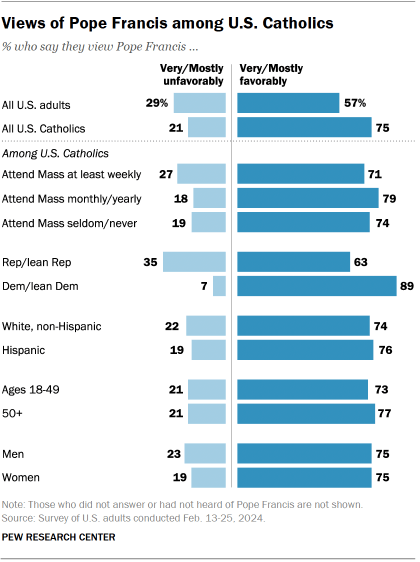
The 75% favorability rating for Pope Francis by U.S. Catholics represents a decrease of 8 points from the last time we asked this question, in September 2021. Then, 83% said they viewed him mostly or very favorably.
The overall drop in favorability reflects growing dissatisfaction with the current pope among Catholics who identify as Republicans or independents who lean toward the Republican Party. Fully 35% of Catholic Republicans and Republican leaners now say they have an unfavorable view of Pope Francis, compared with just 7% of Catholic Democrats and Democratic leaners.
This survey marks the first time that more than 28% of Catholic Republicans have expressed unfavorable views of Francis in roughly a dozen times we have asked this question since his papacy began in 2013.
While Catholic Republicans have grown more negative toward Pope Francis, the views of Catholic Democrats have barely budged over the last decade. The 89% of Catholic Democrats who now express a favorable view of the pontiff is virtually identical to the 87% who said this in our February 2014 survey.
Catholics’ views on this question vary little by race, gender, age or Mass attendance.

As previously noted, about seven-in-ten Catholics see Pope Francis as representing either a major (42%) or minor (30%) change in the direction of the church.
The view that Francis represents a big change for the church is especially pronounced among Catholics who view him unfavorably.
Among those with an unfavorable view of the pope, 54% say he represents a major change in direction for the church, while 20% say he represents a minor change.
Those who view Francis favorably are less likely than those with unfavorable views to see him as a major change (41%), and more likely to say he represents a minor change (35%).
Big differences between Mass-attending Catholics and those who don’t go
Catholics who attend Mass regularly (once a week or more) are far more inclined than those who go less often to say the church should take a traditional or conservative approach on questions about the priesthood and sexuality.
For instance, 65% of weekly Mass attenders say the church should not recognize the marriages of same-sex couples. And 56% say the church should not allow women to become priests.
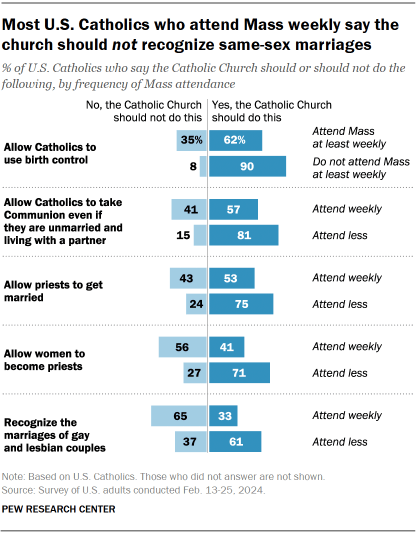
By comparison, most Catholics who don’t attend Mass weekly say the church should recognize the marriages of same-sex couples (61%) and ordain women priests (71%).
There are similar differences in opinion on the survey’s questions about contraception, allowing priests to marry, and allowing Communion for Catholics living with a romantic partner outside of marriage. However, on all three questions, half of Catholics or more in both groups – those who attend regularly and those who don’t – say the church should take these steps.
The survey also shows that Catholic Democrats are more likely than Catholic Republicans to say they want the church to allow married priests, women priests, contraception, same-sex marriages and access to Communion for those living with a partner outside of marriage.
Older Catholics, White Catholics and Catholic women tend to be a bit more inclined than younger Catholics, Hispanic Catholics and Catholic men to say the church should make these changes, though differences by age, race and ethnicity, and gender are often modest and aren’t seen on every question.
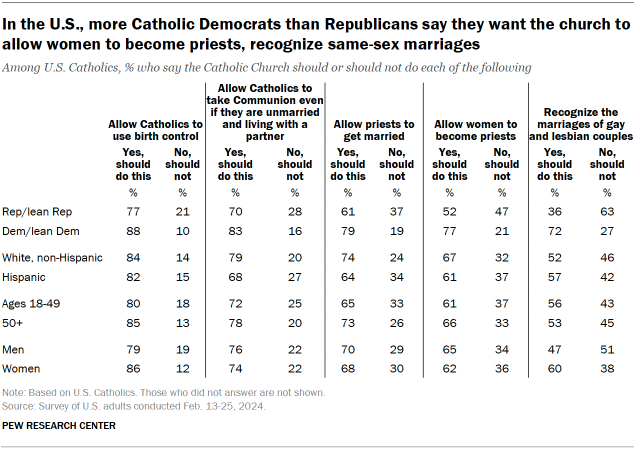
Trends over time
Pew Research Center previously asked these questions (or similar questions) about the Catholic Church’s approach to the priesthood and sexuality in telephone surveys conducted between 2013 and 2015. The switch in survey mode (from telephone to web) means it’s important to use caution when comparing results over time. 1
Nevertheless, the data suggests there has been an increase over the last decade or so in the share of Catholics who favor allowing unmarried people who are living with a romantic partner to receive Communion. There also appears to be a slight increase in the share of Catholics who say the church should allow birth control.
The shares of Catholics who say the church should allow priests to get married, allow women to become priests and recognize the marriages of gay and lesbian couples are in the same ballpark as they were a decade ago.
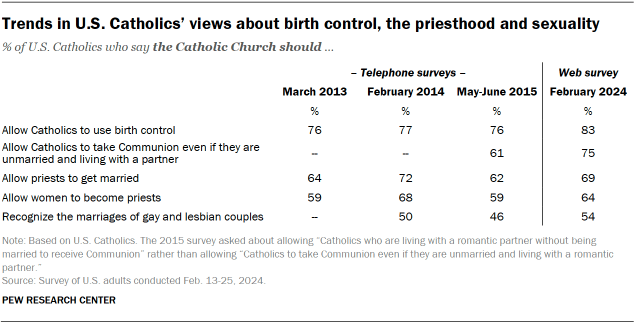
Summing up views about the Catholic Church’s approach to priesthood, sexuality
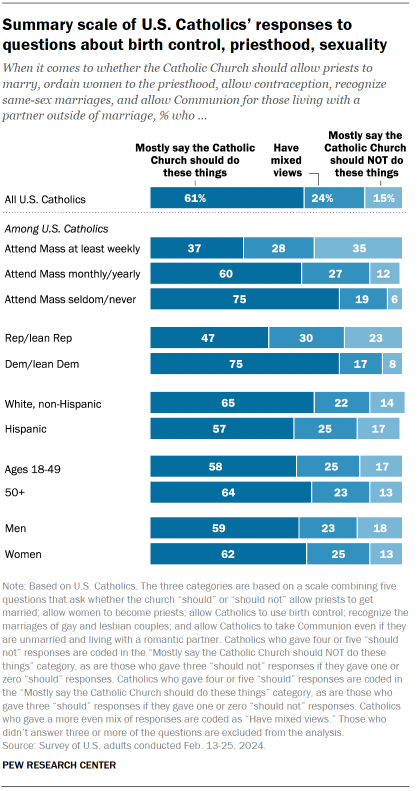
We created a scale to summarize U.S. Catholics’ views about whether the church should or should not do the following things:
- Allow Catholics to use birth control
- Allow Catholics to take Communion even if they are unmarried and living with a romantic partner
- Allow priests to get married
- Allow women to become priests
- Recognize the marriages of gay and lesbian couples
Overall, 61% of Catholics mostly say the church should take these steps, while 15% of Catholics mostly say the church should not . About a quarter express mixed views, saying the church should do some of these things but not others. 2
Weekly Mass attenders are much more likely than those who go less often to say the church should not do these things. Even among weekly Mass-goers, though, roughly one-third mostly say the church should allow contraception, marriage for priests, women’s ordination to the priesthood, Communion for couples living together outside of marriage, and recognition of same-sex marriages.
Catholic Democrats and Democratic leaners are much more likely than Catholic Republicans and Republican leaners to say the church mostly should bring about these changes. Meanwhile, Catholic Republicans are more likely than Catholic Democrats to say the church mostly should not take these steps.
Profile of Catholics by their views on whether the church should/should not allow contraception, marriage for priests, and more
Another way to analyze these findings is to flip the lens and analyze the data from the other direction – to ask: Who are the Catholics who mostly say the church should not allow contraception, marriage for priests, women’s ordination, Communion for cohabiting couples or recognition of same-sex marriages? And who are the Catholics who mostly say the church should do these things?
Among Catholics who mostly say the church should not do these things:
- 59% say they attend Mass at least once a week.
- 72% identify with or lean toward the Republican Party.
By contrast, among Catholics who mostly say the church should do these things:
- 56% say they seldom or never attend Mass.
- 57% identify with or lean toward the Democratic Party.
The share of White Catholics in the “mostly should not” category is modestly lower (at a 90% confidence level) than the share of White Catholics in the “mostly should” category.
And the share of men in the “mostly should not” category is modestly higher (at a 90% confidence level) than the share of men in the “mostly should” category.
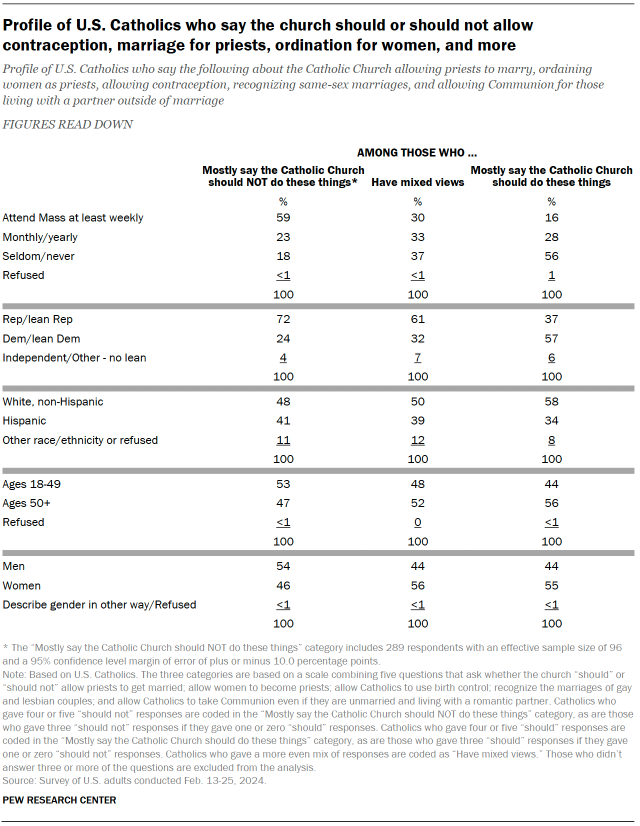
- Surveys conducted online versus on the phone sometimes produce different estimates resulting from the method in which the survey was conducted, a phenomenon called “mode effect.” One potential mode effect is that when speaking to a live interviewer over the telephone, respondents are more likely to offer responses that are socially desirable, or which paint them in a positive light. Additionally, in surveys conducted online, respondents may be less likely to decline to answer the question. For more on how differences in survey mode can effect responses to religion questions, read the Center’s 2021 report “Measuring Religion in Pew Research Center’s American Trends Panel.” ↩
- The “Mostly say the Catholic Church should do these things” group includes Catholics who answer four or five of these questions by saying “should,” as well as those who answer “should” three times as long as they didn’t say “should not” to more than one of the questions. The “Mostly say the Catholic Church should NOT do these things” group includes Catholics who answer four or five of these questions by saying “should not,” as well as those who answer “should not” three times as long as they didn’t say “should” to more than one of the questions. Catholics who gave a more even mix of “should” and “should not” responses are coded as “Have mixed views.” People who declined to answer three or more of these five questions are excluded from the analysis. ↩
Sign up for The Briefing
Weekly updates on the world of news & information
- Catholicism
- Partisanship & Issues
- Pope Francis
- Religion & Politics
- Religious Leaders & Institutions
- Same-Sex Marriage
Changing Partisan Coalitions in a Politically Divided Nation
5 facts about religion and americans’ views of donald trump, 8 in 10 americans say religion is losing influence in public life, u.s. christians more likely than ‘nones’ to say situation at the border is a crisis, religious ‘nones’ in america: who they are and what they believe, most popular, report materials.
1615 L St. NW, Suite 800 Washington, DC 20036 USA (+1) 202-419-4300 | Main (+1) 202-857-8562 | Fax (+1) 202-419-4372 | Media Inquiries
Pope Francis to visit 4 nations across Asia and Oceania in September
By Devin Watkins
The Holy See Press Office announced on Friday that Pope Francis will visit three nations in Asia and one in Oceania in early September.
He accepted the invitation of the Heads of State and local Church authorities to make what will be his 45th Apostolic Journey abroad.
The Pope is scheduled to depart Rome on September 2 and return on September 13.
He travels first to Jakarta, the capital of Indonesia, where he will land on September 3 and remain until September 6.
Pope Francis will then fly east to visit Port Moresby, the capital of Papua New Guinea, and Vanimo on September 6-9.
His next stop will be in Dili, the capital of Timor-Leste, on September 9-11.
From there, the Pope will travel to Singapore for a 3-day visit on September 11-13.
According to the Holy See Press Office, the full programme of his Apostolic Journey will be published at a later date.
Local Catholic population
Pope Francis first mentioned the possibility of traveling to the region in December 2023.
In an interview with the Mexican broadcaster N+, he said he hoped to travel to “Polynesia” in August and to his native Argentina later in the year.
Then, in January 2024, the Pope told an interviewer with the Italian newspaper La Stampa that he would visit Timor-Leste, Papua New Guinea, and Indonesia.
Indonesia is the world’s largest Muslim-majority country, and Catholics number over 8 million, or 3.1 percent of the population.
Around 32 percent of Papua New Guinea’s population are Catholic, numbering around 2 million.
Timor-Leste is overwhelmingly Catholic, accounting for around 96 percent of the population, counting over 1 million people.
Some 395,000 Catholics live in Singapore, representing around 3 percent of the population.
Thank you for reading our article. You can keep up-to-date by subscribing to our daily newsletter. Just click here

More upcoming events:
The Pope's Agenda

Listen to our podcasts

Subscribe to our newsletters
To get the latest news

Regina Coeli

Papal audiences

Daily readings

Saint of the day


IMAGES
COMMENTS
Pope Francis visited North America— Cuba and the United States —from 19 to 27 September 2015. [1] [2] It was his first state visit to both Cuba and the U.S., [3] as well as the third official papal visit to Cuba and the seventh to the United States since the U.S. established full diplomatic relations with the Holy See in 1984.
In his 14-hour New York adventure, Pope Paul VI visited St. Patrick's Cathedral on 5th Avenue, making a speech to assembled American Catholics in his slight Italian accent. Upon his arrival at JFK ...
Pope Francis made his first visit to the United States in September 2015, meeting followers and dignitaries in Washington, New York and Philadelphia. Explore the full coverage from The Times.
When Pope Paul VI touched down in New York City on Oct. 4, 1965, he became the first pontiff to visit the Western Hemisphere. Pope John Paul II made seven trips to the United States over two decades.
Here Are the Best Instagram Photos of Pope Francis' Visit ... Mandel Ngan—AFP/Getty Images Pope Francis arrives to the United States from Cuba at Joint Base Andrews, Md., on Sept. 22, 2015.
Pope John Paul II. With five official visits to the United States and two stopovers in Alaska, John Paul II visited the country more than any other Holy Father. "He was very much a pope on a ...
Papal Visits to the United States. Pope Francis was the fourth pope to visit the theUnited States. His apostolic journey to the United States took place from September 22-27, 2015, and he visited Washington, New York and Philadelphia. Pope Francis' visit was the tenth time a pope made an apostolic journey to the United States.
Last modified on Wed 10 Nov 2021 09.52 EST. Fifty years after the first papal visit to the US, Pope Francis makes a three-city tour of the country which includes attending the World Meeting of ...
Pope Francis visited Washington, New York and Philadelphia during his first trip to the United States. Over six days, he mustered the faithful, impressed many non-Catholics and pleaded for environmental stewardship and compassion for immigrants and the poor in the halls of power: the White House, Congress and the United Nations.
The White House prepares to welcome Pope Francis at the largest arrival ceremony that the Obama administration has held. President Obama delivers remarks welcoming His Holiness Pope Francis to the White House during the Pope's first visit to the United States. September 23, 2015.
Pope John Paul II begins his first trip to the United States: He visits Boston, New York, Philadelphia, Chicago, Des Moines, and Washington, D.C. October 20, 1979 Popestock in Chicago Thomas Geoghegan
Unlike predecessors who traveled to the United States before rising to the papacy, Pope Francis has waited until age 78 to visit the country that thinks of itself as the center of everything.
September 18, 2015 1:00 PM EDT. Correction appended, Sept. 24, 2015. The history of papal visits to the United States is even briefer than one might expect. When Pope Francis arrives in the U.S ...
The crowd chanted "Ho Ho, Hey, Hey Hey, Welcome to the U.S.A." as Francis became the fourth head of the Catholic Church to visit the United States, nearly 50 years after Paul VI made the first ...
Pope Francis is making his first-ever visit to the United States this week, and only the 10th-ever visit by a sitting pope. His trip will take him through DC, New York, and Philadelphia from ...
Pope Francis will make his first visit to the United States in September, with stops in Washington, New York and Philadelphia. His trip will add to the 50-year history of pope visits to the U.S. Pope Paul VI made the first papal visit to the U.S. in October 1965. He addressed the United Nations General Assembly, attended the New York World's ...
In 1979, Pope John Paul II came to the United States and became the first Pope to visit the White House. Pope John Paul II visited the United States a total seven of times. President Jimmy Carter's handwritten notes on meeting with Pope John Paul II during his first visit to the White House, October 6, 1979. (National Archives Identifier 6207614)
Prior to the visit of Pope Francis to Philadelphia on September 26 and 27, 2015, only one other pope had made an official visit to the city. Pope John Paul II, shown here, came on October 3 and 4, 1979, as part of his first trip to the United States as pope. (PhillyHistory.org) While the two papal visits have many similarities, fund-raising for ...
Pastoral visits of Pope Francis This is a list of pastoral visits of Pope Francis. His visit to the Philippines in January 2015 included the largest papal event in history with around 6-7 million attendees in his final Mass at Manila, surpassing the then-largest papal event at World Youth Day 1995 in the same venue twenty years earlier. International visits 2013 Pope Francis visits a favela ...
Things were far more complicated when the first-ever papal visit to the U.S. took place almost exactly 50 years ago. In 1965, Pope Paul VI planned a trip to New York in order to address the then ...
St. Louis, Mo., Jan 2, 2023 / 10:00 am. Pope Benedict XVI, who died Saturday, visited the United States only once, but he left a lasting impression. The spring 2008 trip included a Mass celebrated ...
How we did this. A new Pew Research Center survey finds that 75% of U.S. Catholics view Pope Francis favorably, down 8 percentage points since we last asked this question in 2021 and 15 points below his peak favorability rating, which was 90% in early 2015. Since becoming pope in 2013, Francis often has received favorable ratings from 80% or ...
The Holy See Press Office announced on Friday that Pope Francis will visit three nations in Asia and one in Oceania in early September. He accepted the invitation of the Heads of State and local Church authorities to make what will be his 45th Apostolic Journey abroad. The Pope is scheduled to depart Rome on September 2 and return on September 13.